A Day on the Trail
Historical trails, trail basics - a day on the trail.
Eighteen to twenty miles a day over prairie was considered a good days travel. Pioneers were awakened shortly before daybreak by the sound of a bugle or a shotgun from the guard.
After several days on the trail, certain routines were followed :
4:00 am: A bugler blows a trumpet or a rifle is fired by the night guards to wake up the camp.
5:00 am: Cattle are rounded up after being allowed to graze during the night (except when Indians threatened) .
5:30 am: Women and children are up and fixing breakfast of usually bacon, corn porridge or “Johnny Cakes” made of flour and water.
6:30 am: Women rinse plates and mugs and stow bedding, while the men haul down tents and load them in the wagons.
7:00 am: After every family has gathered their teams and hitched them to wagons, a trumpeter signals a “Wagons Ho,” to start the wagons down the trail. Average distance covered in a day was usually fifteen miles, but on a good day twenty could be traveled.
7:30 am: Men ride ahead on horses with shovels to clear out a path, if needed.
“Nooning Time”: Animals and people stop to eat, drink and rest.
1:00 pm: Back on the trail.
5:00 pm: When a good campsite with ample water and grass is found, pioneers stop to set up camp for the evening. Wagons are formed into a corral.
6:00 pm: Families unpack and make supper.
7:00 pm: Mothers do chores, men smoke and talk, young people dance.
8:00 pm: Camp settles down for the night, guards go out on duty.
Midnight: Night guards are changed.
Pioneer family relax for a photograph
The wagon trail sets out for a day's journey

What You Probably Didn't Know About Covered Wagons
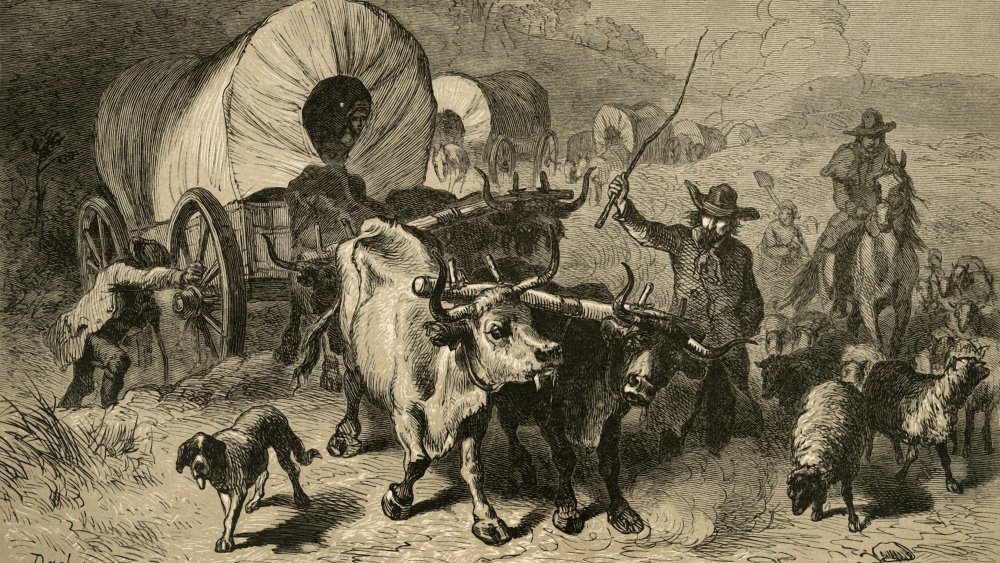
Safety in numbers. Or, if you prefer, misery loves company. Either way, the great Western Migration of the 19th Century was largely accomplished by people crossing the Great Plains, bound from the East, or even what's now the Midwest, en route to the lush lands of Oregon and California, there for the taking, there for the settling — if you survived the trip.
There was no easy way to make a new life for yourself in the 1800s. Not if you wanted to move, and not if you wanted to move a family. Passage by ship around the tip of South America was an expensive and dangerous option. Railroads? The transcontinental railroad wasn't completed until 1869, according to History . Stagecoach? Impractical for families, plus what they might need when you got where you were going — tools, household goods.
Not that the alternative was a whole lot better. While many of the Latter-day Saints made the trip to Utah using handcarts (and walking), relates Historynet , many others would invest in a covered wagon of some kind. There were various sizes available, and of course in this case, size actually mattered — because you had to take into consideration how you were going to move that wagon, loaded up with supplies, tools, and household goods with which to make your new start in a new land.
Most people walked most of the way
They would travel in packs — wagon trains, a collective of like-minded folk, guided by someone who claimed to know where they were going and the best way to get there (though that didn't always work out — ask the Donner Party ). Migration began in earnest with the opening of the Santa Fe Trail in the 1820s, then picked up considerably with wagons headed for Oregon and California in the 1840s, writes Marshall Trimble in True West Magazine . The first wagons generally measured about 10 feet long, four feet wide, and two feet deep, writes Jana Bommersbach, also for True West . Arches over the top of the wagon were covered by heavy canvas. The incredible weight being moved required significant animal power, and so most often, wagons were pulled by teams of oxen, though occasionally mules or horses were utilized instead. Added benefit: an ox wasn't a very attractive target for thieves — they moved slowly, you couldn't ride them, and not particularly tasty. As the trip wore on, and the oxen wore out, it was not unusual for families to start abandoning the things that seemed so important before they left.
The so-called Conestoga wagon was extremely popular until the 1850s — as popular as something as primitive as this could be, anyway — rugged, dependable, and incredibly uncomfortable. One advantage of using oxen was that the family could walk alongside at a relaxed pace.
Wagons were built to endure
On a good day, a wagon train might cover 20 miles — seven days a week, with no holidays, trying to take advantage of good weather before autumn and winter struck, trying to cover some 2,000 miles in about five months. There was a break for lunch, then the evening stop for the night, with beds unrolled underneath the wagon — there wasn't room within for people. Repairs had to be done on the road. The wagons had springs, but if you did try to ride, it was a bone-jarring trip and most people didn't bother. Advancements in wagon design — it's probably a stretch to call it "technology" — resulted in the slightly smaller, perhaps faster, "prairie schooner," replacing the Conestoga in the middle of the century.
Wagon trains, especially the larger groups, were rarely attacked by Native Americans. More problematic was the weather. A swollen river could prove impossible to cross, causing days, even weeks, of waiting. Muddy ground could slow progress. And if the guide was inexperienced, there was always the nightmare of getting lost, losing time, and getting stuck. (Donners, anyone?)
The voyage completed, the wagon often served as temporary shelter
Once arrived in the new territory, the wagon would provide the first shelter for the family, until something a little more permanent could be built, whether of timber or simply prairie sod. The vehicle itself would continue to be used to move what needed moving as the family settled in.
Texas rancher Charles Goodnight is credited (by some) with inventing another form of Old West wagon: the chuckwagon , a rolling kitchen serving the needs of cattle drives. The cook would drive the wagon ahead of the herd during the day, meet up to serve hot food, move ahead again to prepare for the evening, while gathering firewood and perhaps fresh game or even wild bird eggs along the way. It was smaller than the prairie schooner or the Conestoga, and would feature fold-down work spaces, maximized storage for cooking equipment, and no matter who invented it, was generally an ingenious piece of American engineering.
Daily Life on the Oregon Trail: What it Was Really Like
By Molly Jacobson Last updated January 19, 2023

When was the last time your daily routine included helping an ox with his snot-rag or filtering your water through a hanky? For most of us, never. But for over 200,000 pioneers in the mid-1800s, these were just part of a long day on the Oregon Trail.
Thanks to letters, diaries, and personal accounts that have been preserved for nearly 200 years, we get to sneak a peek into the daily lives of these hopeful travelers. They stayed up late, writing by the light of stubby, precious candles; and because of that, we’ve learned that most days on the Oregon Trail were, by and large, the same.
Life on the Oregon Trail
Of course, there were many one-off days spent fording a river, “laying by” to rest the animals, or managing mayhem. But for the most part, a day on the Oregon Trail looked something like this schedule.
4 a.m. – Rise and Shine
The crack of a gunshot or the yelp of a bugle awakens the travelers to yet another day of marching through the prairie wilderness.
5 a.m. – Breakfast and Chores
After a night of grazing, the animals are rounded up and “corralled” within the circle of wagons.
The women fry up bacon and stir kettles of corn porridge. They milk the cows and skim off the frothy cream, spooning it into pails, which, swinging to and fro on their jarring journey, will churn it into thick butter for their evening biscuits.
6 a.m. – Break Camp
The men tear down tents, look over the wagons, and tend the animals – wrapping a lame foot or smearing salve on hides rubbed raw. Wise travelers take good care of their animals, knowing that without them, they will likely become one of the 10 graves seen every mile. The author of a popular pioneer guidebook warns:
The success of a long expedition through an unpopulated country depends mainly on the care taken of the animals, and the manner in which they are driven, herded, and guarded. If they are broken down or lost, everything must be sacrificed, and that party becomes perfectly helpless.” U.S. Army Captain Randolph B. Marcy
While the men yoke the oxen and hitch up the mules, the women and children wash the breakfast dishes and stash away the bedrolls. If water is rumored to be scarce up ahead, they fill as many barrels and pots as they can without adding too much weight to the animals’ already hefty loads.

Featured Read
Oregon Trail Stories: True Accounts Of Life In A Covered Wagon
“Taken from actual diaries, letters, memoirs and reminisces, these are true to life experiences from the pioneers themselves.” – William J. Higgins,III, Amazon review
7 a.m. – Wagons Ho!
Once everything is fully loaded and hitched up, a bugler heralds “Wagons Ho” to start the wagons rolling down the trail. According to pioneer Jesse Applegate , it was best to be on time, for “all know when, at seven o’clock, the signal to march sounds, that those not ready to take their proper places in the line of march must fall into the dusty rear for the day.”
Normally, though, each wagon takes turns leading – a relished position after spending the day tasting the gritty dust of the dozens of wagons ahead.
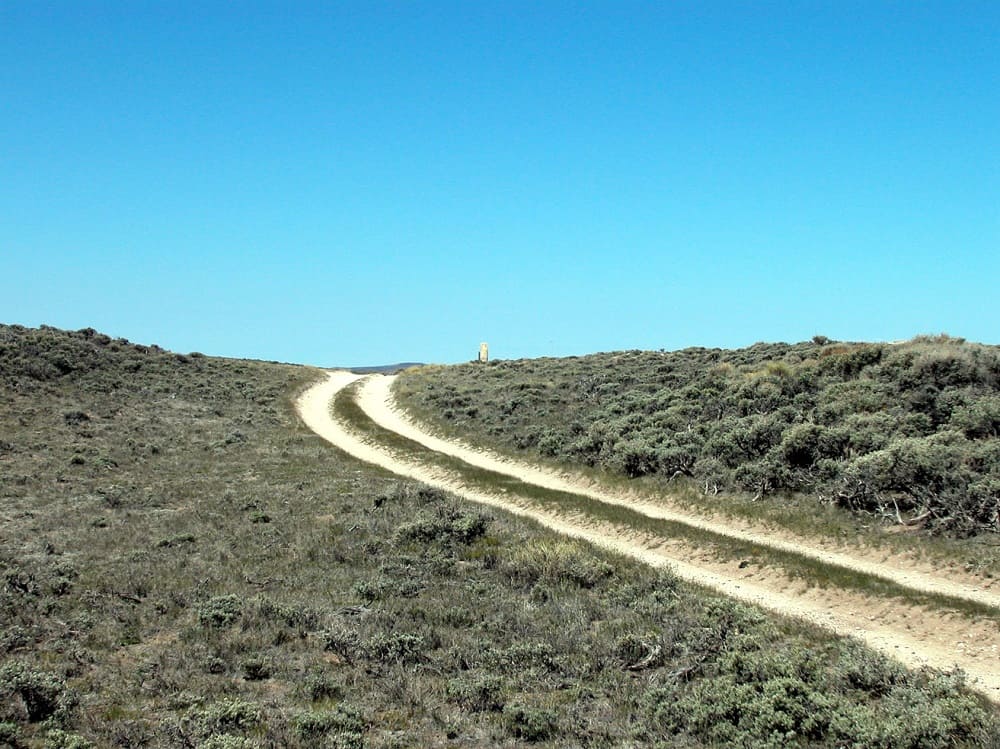
For the next several hours, travelers trudge on to the sound of grasshoppers chirruping, wagon wheels creaking, and foot after plodding foot crunching on dry grass.
Nothing but actual experience will give one an idea of the plodding, unvarying monotony, the vexations, the exhaustive energy, the throbs of hope, the depths of despair, through which we lived.” Luzena Stanley Wilson
If the trail is rough or uncertain, a few men ride ahead on horseback with shovels to scout it out and clear the way.
Along the way, women and children collect kindling and buffalo “chips,” tossing them into the backs of the wagons. The Great Plains were short on timber to begin with, but the earliest pioneers had long ago used up the trees along the trail. Fortunately, travelers like Alonzo Delano discovered a suitable alternative.
Our fuel was dry weeds and buffalo excrement, which served us quite well to boil our coffee and fry our bacon.” Alonzo Delano, 1857
12 p.m. – Nooning Time
After a few hours on the trail, travelers stop for a quick lunch and to water and rest their animals. Before starting up again, young boys wrap up a most important job: wiping the oxen’s noses with a damp rag to keep the trail dust from accumulating and choking them.
Typically, the nooning time is just an hour. In the heat of summer, though, some parties opt to “lay by” for a few hours, preferring instead to travel at night and in the cooler hours of the day.
Related read : 7 Tantalizing Stories of Lost Treasure in Oregon
1 p.m. – Back on the Trail
The emigrants resume their journey.
Most walk to avoid adding any extra weight to the wagons. But frequently, injured, sick, or laboring travelers have no choice but to ride in their bumpy wagons. One in five women on the trail are pregnant. They suffer birth pains as the travelers roll onward; their wagon pulling over only briefly, when it’s time to push.
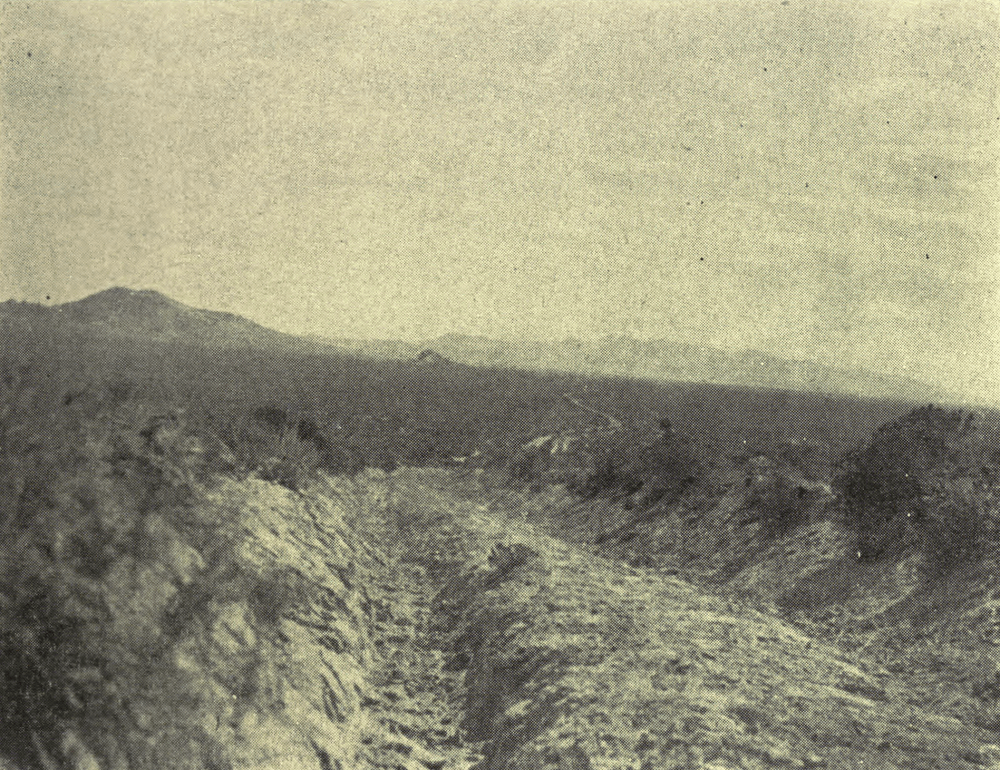
Men and boys keep an eye out for wild game or take off on a hunting party, hoping to bring back fresh meat for supper and save their cattle for when no game can be found. Earlier pioneers find buffalo, antelope, and deer plentiful; but the thinning of wild herds necessitates that later travelers pack their own meat for the journey “on the hoof.”
Related read : 9 Reasons Why Fort Bridger was the Worst Fort on the Oregon Trail
5 p.m. – Make Camp
The pioneers search for a campsite – ideally, an easily defendable location with plenty of grass for grazing and access to clean water.
It is the practice of most persons traveling with large ox trains to select their camps upon the summit of a large hill, where the surrounding country in all directions can be seen. Their cattle are then continuously within view from the camp, and can be guarded easily.” Captain Randolph B. Marcy, 1859
Once they’ve spotted a decent campsite, the travelers circle the wagons, forming a corral, and set up camp. The humble horseshoe of linked wagons formed a nigh-impenetrable fence with a 20-yard opening that could be closed with a couple of ropes to keep the animals contained.
It is a strong barrier that the most vicious ox cannot break, and in case of an attack of the Sioux would be no contemptible entrenchment.” Jesse Applegate, 1843
Freshly unyoked, the animals are let out to graze on the plains, but under watch. Indian attack is always on their worried minds. Occasionally, Indians would ride through the herds, causing stampedes and pilfering a few cattle or horses.
6 p.m. – Suppertime
The men tend to the animals and wagons, making any necessary repairs.
The women unpack, forge their makeshift hearths, and start supper. Children fish or gather berries, wild onions, and buffalo chips.
Meals are simple – cobbled together from whatever can be hunted, caught, gathered, or made from a family’s meager supplies.
The journey overland is a great leveler of the classes – even if a family can afford more than the bare necessities, their team likely won’t be able to pull it, so most end up hauling more or less the same pantry.

Captain Marcy recommends 110 days’ worth of food. A family of four requires 600 pounds of flour, 120 pounds of biscuits, 400 pounds of bacon, 60 pounds of coffee, 4 pounds of tea, 100 pounds of sugar, and 200 pounds of lard, as well as rice, beans, and dried fruit.
A few fortunate families herd fresh milk, cream, and butter along as well, trailing the family milk cow behind the wagon. Some travelers enjoy fresh eggs, thanks to a small flock stowed in their schooners or purchased from farmers along the eastern wing of the trail. If they don’t bring their eggs with them “on the hoof,” the women tuck dozens of them safely into barrels of cornmeal or flour.
The emigrants, many of whom nearly starved, were thankful for whatever food they could find, be it varmints or roadkill.
In 1854, Tabitha Brown wrote:
The Canyon was strewn with dead cattle, broken wagons, beds, clothing, and everything but provisions of which we were nearly destitute. Some people were in Canyon two and three weeks before they could get through; some died without any warning from fatigue and starvation; others ate the flesh of the cattle that were lying dead by the wayside.” Covered Wagon Women, Volume 1: Diaries and Letters from the Western Trails, 1840-1849
Another traveler writes of the joy of harvesting fresh meat, meager as it was.
Hauled the seine, and caught a number of suckers and trout. Captured several fat black mice and had a pie.” Joseph Goldsborough Bruff, August 12, 1849
7 p.m. – Evening ‘Round the Campfire
After supper, the women and children wash the dishes and do evening chores. The men smoke and talk, while their wives mend frayed hems and visit. Some make notes in a diary or write letters back East and tuck them into apron pockets to be mailed at the next fort.
A fiddle and dancing light up the prairie nights, and sometimes the travelers even celebrate a wedding.
It was a pretty sight, the circular correll [sic] of white topped wagons and tents scattered here and there, the blazing fires shining through the trees, the busy men and women hurrying to and fro, and the quiet moon looking down over it all.” Ellen Gordon Fletcher, 1866
Most nights, the animals are left out to graze on the prairie and then rounded up again in the morning. Occasionally, if Indians threaten to attack or steal their stock, the pioneers keep their animals corralled all night, then let them out before sunrise to graze again.
8 p.m. – Lights Out
In preparation for another long day of marching over mountains and meadows, travelers go to bed early. The first night watchmen take to their posts.
Midnight – Changing of the Guard
The second night watch takes over.
Daily Struggles on the Oregon Trail
On a good day, Oregon Trail emigrants logged 18-20 miles, but the average day’s journey was about 15 miles. Some days, they gained no ground – in an unsettled land, it was easy to get lost and have to double back.
According to historian Aubrey L. Hanes, the trail “was hardly a thoroughfare in the modern sense, but more of a “travel corridor.” Two different parties could be traveling parallel in the same Westward direction, but with miles between them.
Directions were sketchy and feeble maps hand drawn. Many time-pressed pioneers embarked on untested “short-cuts,” including the notorious Donner Party , most of whom perished in the snow-packed Sierra Mountains – but not before being forced to resort to cannibalism.
Often, travelers spent less time traveling and more time fording rivers, hunting, or rounding up lost animals. Every now and then, the waggoners spent a day or two “laying by,” washing clothes or letting their animals recuperate, especially before a long stretch of desert.
Young pioneer Sarah Royce was advised to cut and dry hay for their oxen’s dry journey ahead, as well as to fill up every last container she had with water. Sarah’s party used up every last bit of hay and water as they crossed 40 miles of desert east of the Great Salt Lake . Not only that, Sarah had to tear open their straw mattresses and feed them to the oxen.
Most parties marched seven days a week, despite the most devout begging for a Sabbath’s rest. However, time and experience proved that six good days of travel was much more efficient than seven wearied and ragged ones.
Three Daily Tasks of Life on the Oregon Trail
Regardless of how far they traveled in a day, all pioneers were consumed by three main daily concerns: finding grass for their animals, gathering enough fuel for a fire, and searching for clean water.
The further west they traveled, the tougher the terrain became.

Large gaps between streams forced a more desperate daily quest for water. Travelers faced a crippling conundrum: a fresh water source was frequently lacking, and even when they found one, they couldn’t haul much because it was too much of a strain on their oxen. They had to keep moving forward, trusting and hoping that there would be enough water somewhere up ahead.
Even when they had water, it was – as Alonzo Delano wrote – “execrable.” All pioneers, even young children, relied on coffee. It was often the only way to stomach the bitter, alkali water.
Travelers frequently drink muddy water by placing a cloth or handkerchief over the mouth of a cup to catch the larger particles of dirt and animalcula.” Captain Randolph B. Marcy, 1859
It’s obvious that traveling on the Oregon-California Trail was no picnic, but nobody captures the essence of the daily drudgery like ’49er Luzena Stanley Wilson.
Day after day, week after week, we went through the same weary routine of breaking camp at daybreak, yoking the oxen, cooking our meager rations over a fire of sagebrush and scrub-oak; packing up again, coffeepot and camp-kettle; washing our scanty wardrobe in the little streams we crossed; striking camp again at sunset, or later if wood and water were scarce. Tired, dusty, tried in temper, worn out in patience, we had to go over the weary experience tomorrow. No excitement, but a broken-down wagon, or the extra preparation made to cross a river, marked our way for many miles.” Luzena Stanley Wilson
Now, nearly 200 years later, our overloaded to-do lists may seem endless – but they’re not 2,000 miles long. And (thankfully) they usually don’t include mouse pie or buffalo chips.
Read more about American expansion across the West:
- Prairie Pioneers: True & Inspiring Oregon Trail Stories
- Hope Deferred: 16 Iconic Landmarks on the Oregon Trail
- Hell on Wheels History: Rowdy Railroad Towns Across the Plains
- Why Did People Move West in the 1800s?
- 10 Famous Guns of the Old West, from Revolvers to Rifles
Further Reading
- The Oregon Trail: A New American Journey , Rinker Buck
- The Oregon Trail: An American Saga , David Dary
- Westward Vision: The Story of the Oregon Trail , David Lavender
- Days On The Road: Crossing The Plains In 1865 , Sarah Raymond Herndon
by Molly Jacobson
Molly Jacobson is a freelance journalist based near Miles City, Montana, where she wrangles five babies, twenty chickens, and one emotionally unstable dog. She has a B.A. in Psychology from Gonzaga University and writes for mental health blogs, history websites, two local newspapers, and anyone else who doesn't mind her flagrant abuse of the maximum allowed word count.
Discussion (0)
Leave a reply cancel reply.
Your email address will not be published. Required fields are marked *
Related Posts

7 Tantalizing Stories of Lost Treasure in Oregon
Even if all you had to go on was what you learned in movies, you probably know that…
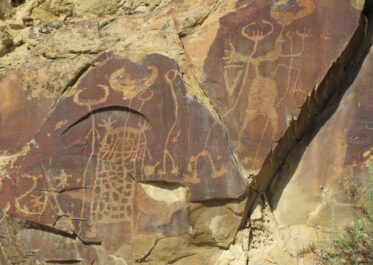
10 Places to See Native American Pictographs & Petroglyphs in the West
Humans have been creating rock art since paleolithic times. The oldest known of which (so far) is cave…

20 Wild West Towns Where You Can Still Experience the Frontier
When it comes to Old West towns, most people think of empty dirt streets filled with tumbleweeds and…

17 Epic Facts about the Transcontinental Railroad
When the Golden Spike connected Central Pacific and Union Pacific rails at Promontory Summit, Utah, in May 1869,…
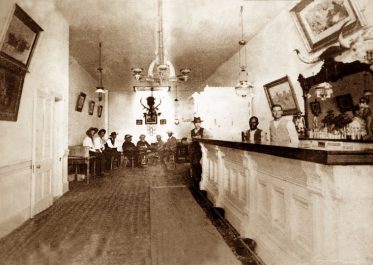
10 Interesting Facts About Long Branch Saloon, Dodge City’s Infamous Watering Hole
Fans of the television show Gunsmoke may have fond memories of the Long Branch, Dodge City, Kansass lively…
- History Classics
- Your Profile
- Find History on Facebook (Opens in a new window)
- Find History on Twitter (Opens in a new window)
- Find History on YouTube (Opens in a new window)
- Find History on Instagram (Opens in a new window)
- Find History on TikTok (Opens in a new window)
- This Day In History
- History Podcasts
- History Vault
9 Things You May Not Know About the Oregon Trail
By: Evan Andrews
Updated: August 3, 2023 | Original: November 13, 2015

For American settlers heading westward in the 19th century, the Oregon Trail offered the primary route. A rugged path marked only by the parallel wheel ruts dug by thousands of covered wagons, it led across nearly 2,200 miles of prairie, desert and mountain terrain from Independence, Missouri to Oregon City, Oregon. After explorers Meriwether Lewis and William Clark mapped the uncharted land in 1804-06, merchants, trappers, miners, traders and missionaries soon followed, looking for land, resources and opportunity. By mid-century, wagon traffic on the route expanded to tens of thousands annually. Here are nine surprising facts about the Oregon Trail:
1. The Oregon Trail didn’t follow a single set path.
While most Oregon-bound emigrants traveled a route that passed by landmarks in Missouri, Kansas, Nebraska, Wyoming, Idaho and Oregon, there was never just one set of wagon ruts leading west. Pioneers often spread out for several miles across the plains to hunt, find grazing patches for their animals and avoid the choking dust clouds kicked up by other wagon trains. As the years passed, enterprising settlers also blazed dozens of new trails, or cutoffs, that allowed travelers to bypass stopping points and reach their destination quicker. These shortcuts were especially popular in Wyoming, where the network of alternative pathways meandered more than a hundred miles north and south.
2. A pair of Protestant missionaries made one of the trail’s first wagon crossings.
Frontier explorers and fur trappers blazed the rough outlines of the Oregon Trail in the early 19th century, but the route was initially considered too demanding for women, children or covered wagons to navigate. That changed in 1836, when newlywed missionaries Marcus and Narcissa Whitman took a small party of wagons from St. Louis to the Walla Walla Valley to minister to Cayuse Indians. 28-year-old Narcissa became the first white woman to traverse the Rocky Mountains, and her colorful letters home were later published in Eastern newspapers, convincing many would-be pioneers that it was possible for their families to survive the journey west. Still, it wasn’t until 1843 that the pioneer dam finally burst. That year, Marcus helped lead the first major wagon train of around 1,000 settlers along the Oregon Trail, an exodus now known as the “Great Migration.” Traffic soon skyrocketed, and by the late-1840s and early 1850s, upwards of 50,000 people were using the trail each year.
3. The iconic Conestoga wagon was rarely used on the Oregon Trail.

Popular depictions of the Oregon Trail often include trains of boat-shaped Conestoga wagons bouncing along the prairie. But while the Conestoga was an indispensable part of trade and travel in the East, it was far too large and unwieldy to survive the rugged terrain of the frontier. Most pioneers instead tackled the trail in more diminutive wagons that become known as “prairie schooners” for the way their canvas covers resembled a ship’s sail. These vehicles typically included a wooden bed about four feet wide and ten feet long. When pulled by teams of oxen or mules, they could creak their way toward Oregon Country at a pace of around 15 to 20 miles a day. They could even be caulked with tar and floated across un-fordable rivers and streams. Prairie schooners were capable of carrying over a ton of cargo and passengers, but their small beds and lack of a suspension made for a notoriously bumpy ride. With this in mind, settlers typically preferred to ride horses or walk alongside their wagons on foot.
4. The trail was littered with discarded supplies.
As traffic on the Oregon Trail increased, a bustling industry of frontier trading posts sprang up to supply food and equipment for the five-month haul. In popular jumping-off points like Independence, Missouri, unscrupulous merchants made a killing by conning frightened pioneer families into buying more provisions than they actually needed. The overloading meant that many sections of trail became junk heaps filled with discarded food barrels and wagon parts. Broken down prairie schooners and dead draft animals also littered the roads, and it wasn’t unusual to see personal items like books, clothes and even furniture. Fort Laramie in Wyoming eventually became known as “Camp Sacrifice” for its reputation as an Oregon Trail dumping ground. During the Gold Rush of 1849, pioneers reportedly abandoned a whopping 20,000 pounds of bacon outside its walls.
5. Indian attacks were relatively rare on the Oregon Trail.
Contrary to the depictions of dime novels and Hollywood Westerns, attacks by the Plains Indians were not the greatest hazard faced by westbound settlers. While pioneer trains did circle their wagons at night, it was mostly to keep their draft animals from wandering off, not protect against an ambush. Indians were more likely to be allies and trading partners than adversaries, and many early wagon trains made use of Pawnee and Shoshone trail guides. Hostile encounters increased in the years after the beginning of the Civil War, but statistics show only around 400 settlers were killed by natives between 1840 and 1860. The more pressing threats were cholera and other diseases, which were responsible for the vast majority of the estimated 20,000 deaths that occurred along the Oregon Trail.
6. Pioneers left behind graffiti on 'register rocks' along the trail.
Along with painting messages and mottos on their wagon canvasses, pioneers also developed a tradition of carving their names, hometowns and dates of passage on some of the stone landmarks they encountered during their journey west. One of the most notable prairie guest books was Independence Rock, a 128-foot-tall granite outcropping in Wyoming dubbed “The Register of the Desert.” Thousands of travelers left their mark on the rock while camping along the nearby Sweetwater River. Those in a hurry sometimes even paid stonecutters a few dollars to carve their messages for them. In addition to Independence Rock, pioneers also left behind signatures on Register Cliff and Names Hill, two other sites in Wyoming.
7. Most Oregon Trail pioneers didn’t settle in Oregon.
Only around 80,000 of the estimated 400,000 Oregon Trail emigrants actually ended their journey in Oregon’s Willamette Valley. Of the rest, the vast majority splintered off from the main route in either Wyoming or Idaho and took separate trails leading to California and Utah. The California Trail was eventually traveled by some 250,000 settlers, most of them prospectors seeking to strike it rich in the gold fields. The Utah route, meanwhile, shuttled roughly 70,000 Mormon pilgrims to the lands surrounding Salt Lake City.
8. One of the trail’s most famous pioneers made the crossing by wagon, train, automobile and airplane.

One trip on the Oregon Trail was more than enough for most pioneers, but Ohio native Ezra Meeker eventually made the trek a half-dozen times using nearly every available means of conveyance. The unusual odyssey began in 1906, when the 76-year-old jumped behind the reins of a covered wagon and retraced the steps of his original pioneer journey from 54 years before. Meeker was concerned that the legacy of the Oregon Trail was being forgotten, so he made frequent stops to give lectures on its history and install homemade “Meeker Markers” at pioneer landmarks. The trip made him a national celebrity. Crowds gathered to mark his arrival in major cities, and he eventually piloted his wagon all the way to Washington, D.C. for a meeting with President Theodore Roosevelt. Meeker went on to journey the Oregon Trail several more times by wagon, train and automobile. His final crossing came at age 94, when he made the trip in a biplane flown by famed pilot Oakley Kelly.
9. Wheel ruts from Oregon Trail wagons are still visible today.
By the time the last wagon trains crossed in the 1880s, mass migration on the Oregon Trail had left an indelible mark on the American frontier. Decades of prairie schooner traffic carved up certain sections of the trail, leaving imprints in stone and wearing down grasslands so much that nothing grows on them to this day. These pioneer wagon ruts can still be seen in all six of the states that once encompassed the trail.

HISTORY Vault: America the Story of Us
America The Story of Us is an epic 12-hour television event that tells the extraordinary story of how America was invented.

Sign up for Inside History
Get HISTORY’s most fascinating stories delivered to your inbox three times a week.
By submitting your information, you agree to receive emails from HISTORY and A+E Networks. You can opt out at any time. You must be 16 years or older and a resident of the United States.
More details : Privacy Notice | Terms of Use | Contact Us

Westport Landing, outside Kansas City, Missouri, was one of the launch points for wagons on the Oregon Trail.
How a 2,000-Mile Trail Helped Define The American Mindset
An author retraces the Oregon Trail in a covered wagon and learns about mules and the importance of seeing America in slow-mo.
Many books have been written about the Oregon Trail, the 2,000-mile-long route across the High Plains that shuttled millions of pioneers to the American West. But when award-winning journalist, Rinker Buck, discovered that no one had made the epic journey by covered wagon since 1909, he jumped at the chance.
Growing up on a horse farm in New Jersey, he was familiar with driving mule teams and having roped in his brother, Nick, they set off together across America. The Oregon Trail: A New American Journey is the story of that epic crossing.
Talking from his summer home in Maine, he describes how the Oregon Trail shaped the American character; why it is important to travel slowly; and how methamphetamine is leaving a trail of tears in the footprints of the pioneers across today’s Midwest.
You come from a family with 11 children. How did you end up with a name like Rinker?

[Laughs] My parents were very ambitious for unique names. The first four children, Dempsey, Turniham, McNamara, Rinker, were named after our grandparents’ surnames. After that it became Bridget, Brian, Patty, Nicky, because they ran out of original names. My grandmother was a Rinker, a Swiss-German name from Pennsylvania. So, I’m Rinker. Everyone has always told me, “That’s a great name. You better become a writer.”
You had this crazy idea to retrace the trek the pioneers took by covered wagon from Kansas City, Missouri, to Portland, Oregon. What possessed you?
It was pretty much serendipitous. I was out in Kansas and took a hike along the Oregon Trail . I’m a history nut, one of these guys who buy out every museum bookstore. Two things annoyed me. The first was that I didn’t know more about the Oregon Trail, since my real love is 19th Century America. Second, when I started reading up on the Trail, I was astonished at how different the actual history was from the myths passed down to us as school children.
Women played a much more prominent role developing the Trail; the Indians were friendly. I was planning to write a ‘normal’ book, then I ran across a statement in one of the history books that said, “The last documented crossing of the Oregon Trail by covered wagon was in 1909.” I said, ‘Oh, that’s a better book.’
My brother and I grew up on a horse farm; we know how to drive teams, and that enabled me to say, ‘Well, I can do that.’ So, we did.

A pioneer reenactment takes place at Chimney Rock in Bayard, Nebraska. The landscape feature is one of the most famous landmarks for travelers on the Oregon, California,and Mormon Trails.
Why is the history of the Oregon Trail important to American history?
It’s vital. Between 1843 and the Civil War about a half million American pioneers crossed from around the Missouri River to the Columbia River on the Pacific Coast. After the Civil War, another half million crossed.
That was mainly the stagecoach era, although homesteaders continued to cross in covered wagons up until the 1890’s. It’s also vital for the mindset of the Americans. This 2,000-mile trail across the High Plains completed America as a continental space.
In many ways it also defined our character: the clash of ethnic groups, the determination to succeed no matter the hardship. So many of the issues on the trail, like economic scams by outfitters, religious and ethnic battles, resonate through America today.
I found it fascinating that initially the indigenous people were helpful to the pioneers. It was only after the American government reneged on its promises that the Indian Wars began. Can you tell us about the Plains Indians and how they suffered from this mass migration?
When the White Man came along in the 1840’s in their covered wagons, [the Indians] saw opportunities to trade. They bartered with immigrants for trinkets, supplies and horses. They were very helpful at first. In fact, the ingenuity of the Indians in crossing the rivers was a crucial aspect of the Oregon Trail. You have to ford numerous rivers, and the Shoshones, Pawnees and Sioux, were extremely adept at helping the pioneers make these fords.

Three Sioux Indians survey the plains. Native peoples were helpful to the pioneers at first. But when the United States government reneged on promises, and the white man began to slaughter buffalo—their food source—they turned hostile.
For about 20 years it was very friendly as opposed to the impression that you get from Hollywood movies. But when the Indians realized the White Man was there to slaughter the buffalo, their protein source—and we did, in hellacious numbers—they turned hostile and declared war. They’d also made several treaties with the Great Father in Washington, all of which had been violated. Disease had also decimated their ranks. Plus, the inequality of weapons made it very difficult for them to prevail.
Mules are an essential part of the Oregon Trail history. Can you tell us about your relationship with your mules, Bute, Beck and Jake? What did they teach you?
Getting mules from Europe after we broke off from Great Britain was a huge advance for American society because mules can do so many things better than horses. Because of interbreeding with the wild feral burro, mules have slightly larger cranial capacity and are believed to have higher intelligence, even though people interpret that sometimes as being ornery. They won’t go places horses will go unless they’re reassured that they’re safe.
You have to be constantly “ calling” them, so they know you’re on their side and not going to put them in danger. We were riding along one day and Beck, one of the more crazy mules we had, saw a No Hunting-No Trespassing sign made out of an old truck tire hanging on a fence in Nebraska. She started jumping sideways, like it was a Bogey Man.
A bad mule call would be, “You dumb-ass mule, get going!” Good mule handling, even though you’ve got your feet braced on the footboard and you are pulling with all your might to stop this mule, is, “It’s OK, Beck, good girl; it’s OK, it’s just an old tire.” She hears from the tone of voice you are going to keep her safe.
I have to confess my brothers and I are also completely different and if we had undertaken the task you and your brother, Nick, did, we would have killed each other. How were you two able to get along for such a long period of time?
We’re very different. I’m sort of refined, a writer and college educated. My brother, Nick, is very blue collar and gruff and considers, probably correctly, that anybody with a college education has destroyed their brain and is of no use to society.
But we come from a pretty rugged, tough family and so we were competing like the mules were to show that we had more persistence than the other. Our skill bases also complimented each other. I’d been studying the trail for months and could call ahead and organize everything. Nick was a really great driver.
Whenever anything broke, he could fix it. And we had a lot of breakdowns! I would go over to Nick and say, “Hey, can I help you with these fixes?” He would say, “I don’t want your college-educated butt anywhere near this wagon until I’m done.”
People think that good management is telling people what to do. What I learned on the Oregon Trail was that good management means disappearing as a person, not being dominant or ever giving orders, but allowing each of our personalities to do what they could for the trip.
The Donner Party was the most notorious story of murder and cannibalism on the Oregon Trail. Set that story in the social context of the American ethos.
In 1846, the Donner Party became famous throughout America. They were going to California, across the Sierras. You always tried to get over them by October because it starts to snow that early up in the Rockies. But they left late and got trapped. The story is that, as people died, they ate the bodies, though archeological research at the site pretty much confirms that there probably wasn’t any cannibalism. No matter, it got into the tabloids and was a big story of the day.
What I found in the trail journals was that by the time the pioneers got into the Wyoming desert there were short tempers and a lot of competition for water. A lot of wagon trains had cattle with them, for food. Whenever they crossed a river the cattle would get mixed up, and there’d be tremendous fights over whose cattle was whose. People would pull their guns out and start shooting each other.
I feel that the Oregon Trail years and the stresses and the tensions of the crossing introduced this kind of violence into the American ethos. It’s kind of the standard default of Americans. If things aren’t going right, we pull out a gun. Unfortunately, we’ve seen our share of it in the last couple of years.

Author Rinker Buck, left, with his brother Nicholas, roll down the highway near Marysville, Kansas on their trek along the Oregon Trail.
What were your interactions like with people along the way? Were they interested in your mission?
This was one of the most touching things of our trip: the natural generosity and openness of the American West. On the plains, you could see a covered wagon coming from 30 or 40 miles away. Sometimes, we would get to the intersection and there’d be two ranchers having an argument. “He’s coming to my place!” “No, he’s coming to mine!” It was unending hospitality. Women would take one look at us and say, “Guys, you’re coming back to my house and you’re gonna get a shower.” Everyone wanted to help us.
You had a sign on your wagon—tell us about that?
My father loved horses and carriages and one year he decided it would be a good thing for the family if we took a covered wagon trip between our farm in New Jersey and Pennsylvania. In those days the roads weren’t that busy. But he thought if traffic backed up behind us he should explain to people why this covered wagon was running along the roads in 1958.
So, he had a sign painted that said, “We are sorry for the delay but we want our children, and then in big letters, TO SEE AMERICA SLOWLY.” My brother still had that sign. So, we flipped it over, painted it white on the bare side and we printed in the same type, “We are sorry for the delay but we want to SEE AMERICA SLOWLY.
Why is it important to see it slowly?
One little example: in Kansas, early in the trip, we passed through areas that were rural but still relatively inhabited with little housing developments here and there. The children would see us coming from way across the plains and by the time we got to their driveways they would run out with bags of apples and buckets of water in their little red wagons because they wanted to feed the mules.
I began to notice that the parents of these children were the wrong age. They were all grandparents. I finally asked one man about it and he said, “Oh yeah, you’re gonna see a lot of that as you cross the West. The methamphetamines epidemic and the recession of 2008 combined to make the parents of many of these children spin off into drug abuse.”
You never would have seen that if you were speeding by in a minivan. A slow-moving, covered wagon, travelling at about four miles an hour, turned out to be an almost ideal vehicle for a social observatory to understand and see the America of today.

All three of the great Western trail routes passed through Wyoming’s Sweetwater River, which served as a water resource for both travelers and mules.
How did making this historic journey change you and your perspective on what the pioneers accomplished?
It made me more confident of dreams. I’m this guy who sits around and reads stuff in books. This trip affirmed that you have much deeper wells of persistence and strength in you than you think.
What it told me about the pioneers? America was a very unstable country then. In just about every decade there was a major financial panic . In the panic of 1837 half the banks in America closed; farmers couldn’t buy seed and lost their farms. On a really hot, rough day when Nick and I were crossing the trail, we looked at each other and said, “Nobody would do this unless they had to.” That was my big insight. These were people who were brave in the face of catastrophe. They were forced to go. But somehow they managed and survived.
Simon Worrall curates Book Talk. Follow him on Twitter or at simonworrallauthor.com.
Related Topics
- HISTORY AND CIVILIZATION
You May Also Like

Hebrew wasn’t spoken for 2,000 years. Here’s how it was revived.

The Ghanaian-British poet Nii Ayikwei Parkes discovers the dark secrets of his ancestral Caribbean homeland, in Guadeloupe

In this French seaside town, discover the places in ‘All the Light We Cannot See’

6 books about the UK to read this summer

These Japanese cities may inspire your next haiku

How hitchhiking through America spurred a love of desert walking for author Geoff Nicholson

How meeting Morocco's craftspeople inspired Peter Bellerby to become a globemaker
- Paid Content
- Environment
- Photography
- Perpetual Planet
History & Culture
- History & Culture
- History Magazine
- Mind, Body, Wonder
- Terms of Use
- Privacy Policy
- Your US State Privacy Rights
- Children's Online Privacy Policy
- Interest-Based Ads
- About Nielsen Measurement
- Do Not Sell or Share My Personal Information
- Nat Geo Home
- Attend a Live Event
- Book a Trip
- Inspire Your Kids
- Shop Nat Geo
- Visit the D.C. Museum
- Learn About Our Impact
- Support Our Mission
- Advertise With Us
- Customer Service
- Renew Subscription
- Manage Your Subscription
- Work at Nat Geo
- Sign Up for Our Newsletters
- Contribute to Protect the Planet
Copyright © 1996-2015 National Geographic Society Copyright © 2015-2024 National Geographic Partners, LLC. All rights reserved
- Asian Pacific American History
- Women's History
- Collections
Covered wagons and the American frontier

The launch of privately owned spacecraft to resupply the International Space Station calls to mind another sophisticated "truck" that resupplied pioneer settlers west of the Allegheny Mountains 200 years ago. Rugged but scientifically designed, the Conestoga wagon was the 18-wheeler of its day, the undisputed king of the road in a procession of freight wagons that formed an umbilicus from Philadelphia and Baltimore to ports on the Ohio River. Conestoga wagons carried finished goods and supplies westward and returned with barrels of flour, whiskey, tobacco, furs, coal, iron, and other marketable frontier products. Carrying up to five tons of cargo, they made a crunching sound as they trundled over crushed stones that paved the National Road and the Pennsylvania Road. Their billowing white covers earned them the historical nickname "inland ship of commerce."

Covered wagons helped push the American frontier all the way to the Pacific Ocean, but for western trails the Conestoga wagon morphed into the prairie schooner. Smaller, lighter, and lacking the distinctive curve, prairie schooners carried household goods and some family members—most settlers walked. Prairie schooners have been celebrated in novels , television , and a popular computer game , and the identities of the two wagons often have been blurred. That's where museums can help. In September, the National Museum of American History placed on display its Conestoga wagon from the 1840s. Labels explain that this wagon, one of the largest ones ever made, is a relic of freight hauling in Pennsylvania.
The Conestoga wagon originated near the Conestoga River in southeastern Pennsylvania. The wagon body's unique curved shape jostled items together and prevented cargo from tumbling like tenpins on slopes. Huge, broad wheels glided over rough patches. But Conestoga wagons weren't just practical brutes; they were beautiful. Prominent examples of German-American folk art, they were painted blue with red trim, and decorative iron work on the tool box was black.

Conestoga wagons presented new opportunities to earn a living. The wagoner, like his wagon, was tough, robust, and picturesque. He wore colorful flannel shirts and smoked long, thin cigars nicknamed "stogies." During the three-week, 250-mile journey, he walked, rode the left horse nearest the wagon, or sat on the lazy board, which projected from the left side. In summer he slept outdoors, and in winter he bedded down on a roadside tavern floor near the fireplace. His horses ate from the feed box, which he removed from the rear and attached to the wagon tongue.
The Conestoga wagon era abruptly ended in the 1850s, when railroads connected Philadelphia and Baltimore to the Ohio River. Luckily, several dozen Conestoga wagons have survived in museums and private collections. The Smithsonian acquired its wagon in 1962, the year that John Glenn's orbital flight gave America a foothold in space.
Roger White is an associate curator with the Division of Work and Industry at the National Museum of American History. He is responsible for the museum’s Road Transportation Collection and has blogged about other interesting vehicles in the collection. The Conestoga Wagon will be on display through late December 2012. Watch this time-lapse video of the wagon being assembled in the museum.
Related Stories

Five cool facts about our new Philadelphia-style fire engine

The fabric of the frontier: How textiles help us understand the American West
Mustang memories and a fair to remember
Portland Monthly
- Eat & Drink
- Style & Shopping
- Things to Do
- Arts & Culture
- News & City Life
- Travel & Outdoors
- Home & Real Estate
- Health & Wellness
What's it Like to Travel the Oregon Trail in a Covered Wagon in the 21st Century?
By Fiona McCann July 29, 2015
Rinker Buck on the Oregon Trail. (Photo courtesy Rinker Buck)
When Rinker Buck took a road trip in 2010, he didn’t just slip behind the wheel and put his foot on the gas like your average American road tripper. Instead, he set off in a 19 th century wagon with a team of occasionally cantankerous mules, a Jack Russell called Olive Oyl, and his younger brother Nick. Their route? The full length of the Oregon Trail, making them the first to travel it in over a century.
Buck documents the experience in his acclaimed book The Oregon Trail —hailed by the New York Times as an “absorbing” adventure story, and by the Boston Globe as “charming, big-hearted, impassioned and a lot of fun to read”. Ahead of his reading at Powell’s on Thursday, we caught up with the peripatetic writer to find out why one apparently sane, middle-aged man would travel over 2,000 miles by wagon—and what he learned when he did.
What galvanized you to set off in a covered wagon along a centuries-old trail?
It sounds like an adventure tale but it’s really more driven by history. I was in Kansas, working on a journalism story and I came across a trail mark for the Oregon Trail. As a history nut it bothered me a lot that I didn’t know more about the trail. Then I started researching it. The thing that’s fascinating about the trail is all the things that they don’t tell you in history class. I wanted to tell the real history of the trail. Then in one of the history books I came across this statement that the last documented crossing of the trail was 1909. And I thought, why don’t I just ride the trail?
Was it hard to make it happen?
My brother and I bought some mules, and over the phone I bought a restored 19 th century wagon, and it was that simple. It stopped being that simple the day we left.
So things got challenging pretty quickly...
If I’d known all the problems we were going to have and all the things I’d miss and all the problems I was going to have to solve, we never would have left. The book is sort of an ode to having a dream and then realizing your dream doesn’t make a lot of sense, but to actualize it and follow through on it you’re just going to have to improvise. And more important than the land we crossed was learning to live with uncertainty . So yeah, I still think it was pretty crazy, but there’s a lot to be said for impetuosity.
Were there any moments along the way where you genuinely feared for your life?
Rinker Buck at an Oregon Trail marking. (Photo courtesy Rinker Buck)
There were a few. A few times we had to take bridges across high water. The rivers were so full and the mules would panic when we got up on top of the bridges, because there’s nothing in their DNA that prepares them for being 150 feet above the water.
But the single hardest day and most precarious time was when we took the end of the Sublette-Greenwood Cutoff which is a section of the trail in Western Wyoming. We took it up to 8,300 feet and then in less than two miles we had to descend down a mountainside to 6,000 feet. So we made a 2,000 foot descent in about a mile and a half. It was so steep that the mules were so far below us, and we had to chain our wheels so that the wagons would skid along. The wagon was a little over five feet across and this was all on a trail that was seven feet wide. To the left of us was a 300-foot cliff. So if anything had happened, if the mules had got skittish, we would have gone over the side. That descent took us about two or three hours, and the whole way down we were literally one step away from death.
How did the following in the literal footsteps of the pioneers change your understanding of the trail’s historical context?
All of us, especially big history readers like me, are creatures of our reading, and I’d always pretty much accepted the idea that Americans were bound to do this, that we were too ambitious and too active—this notion of ‘manifest destiny’. But in fact that’s not accurate. Many people were homeless because there were successive bank failures, and that drove a lot of people to the trails. Religious rivalries also became so unbearable that people simply left on the trail because they wanted religious freedom. So those are very different motives than ‘manifest destiny’. Most of these people were on the trail because they had to be, they were financially desperate or very uncomfortable in their lives.
One day, my brother Nick and I were going along, and it had been a long day, one of those days when the wind was always in your face, or the mules were a little cranky, and we both looked at each other in the wagon seat and said, ‘You know, nobody would do this unless they had to. This is too hard.’ That was a big insight, because once you know that from riding the trail, your understanding of American history becomes different.
You highlight the stories of a number of characters from history—pioneers who traveled the trail before you and helped shape the story of America. Who were the standouts for you?
The Oregon Trail
Narcissa Whitman was an evangelist from upstate New York, who decided to go out and ‘educate the Indians’ as far west as she could get. So she and her husband set off, and she became the first white woman to cross the Rockies. But she sent home a series of letters that were published in newspapers, and those letters led to an explosion of traffic on the Oregon trail in much the same way as Cheryl Strayed’s book Wild has done to the PCT. Whitman had this huge impact but she’s completely forgotten today.
I was also impressed by Abigail Scott and Margaret Frink. They defied the stereotype of women crossing the trail, which was that their husbands had forced them into it and their role was to ride the wagon all day and hurry the children along. But these pioneer journalists rode across the trail side saddle.
Another character I really loved was named Ezra Meeker—he was the first trail preservationist. He first crossed as a pioneer, made a fortune raising hops, then lost everything and devoted the rest of his life to promoting the preservation of the Oregon Trail. He went out and put stone markers on it, and the fact that the trail ended up being preserved and marked—that would never have happened without him.
Early on you divested yourself of many items—vegetable steamers, your ironing spray, even your GPS. What was it like to return to all of these afterwards? Did any remain permanently decommissioned?
I think the trip actually had a cleansing effect on me. I’m not as into possessions and living in one place and so forth as I used to be. I’m a lot more itinerant now, sort of a vagabond almost, and I find that I like it. I think the trail gave me coping skills that I was going to need pretty quickly in my life, and it taught me not to be so settled, not so worried about what my house looks like . . . just to live.
Rinker Buck reads from The Oregon Trail at Powell's on Burnside on Thursday, July 31 at 7.30 pm.
Related Content
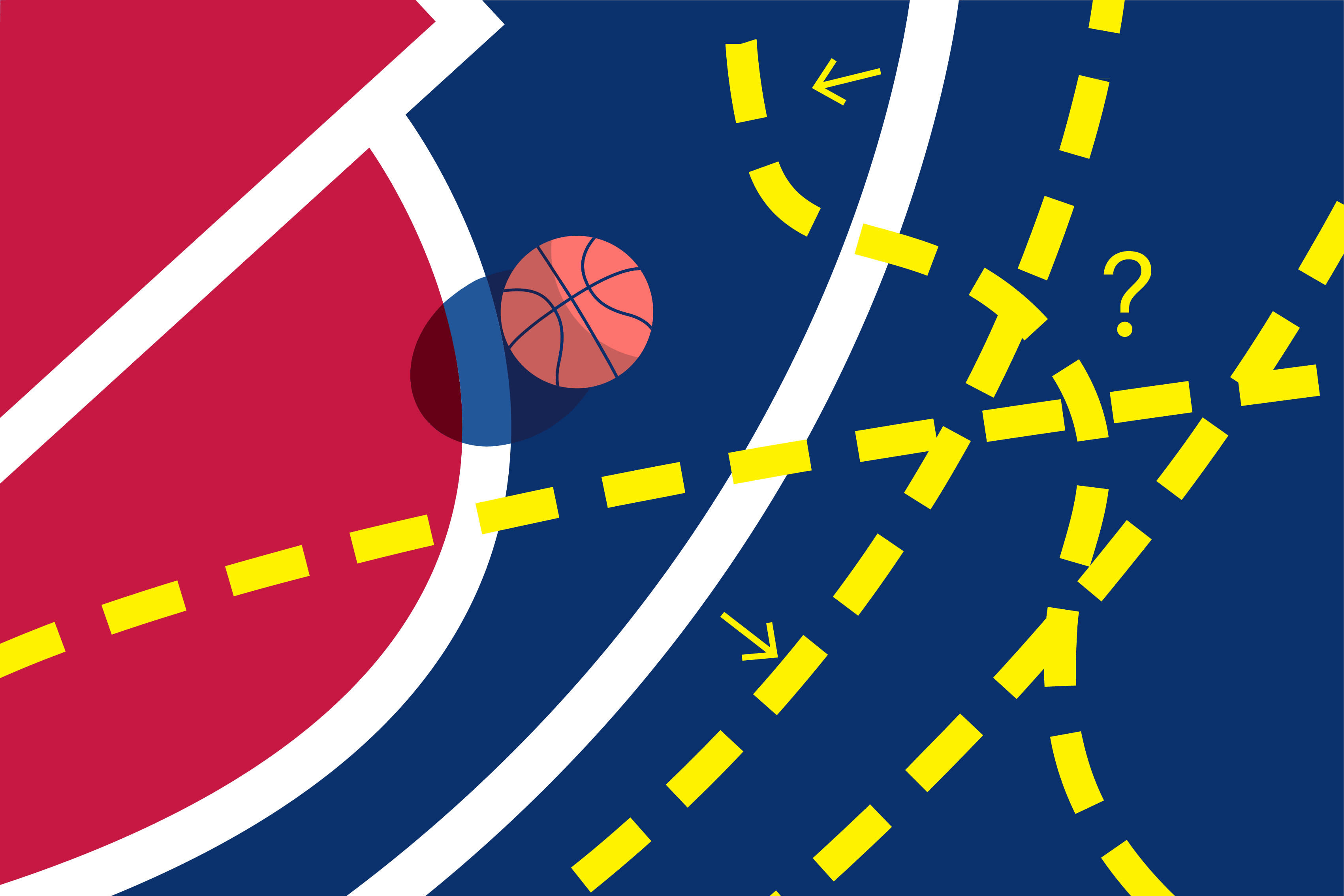
Full Court Press
5 Takeaways from Portland’s March Madness Sweet 16
04/05/2024 By Margaret Seiler
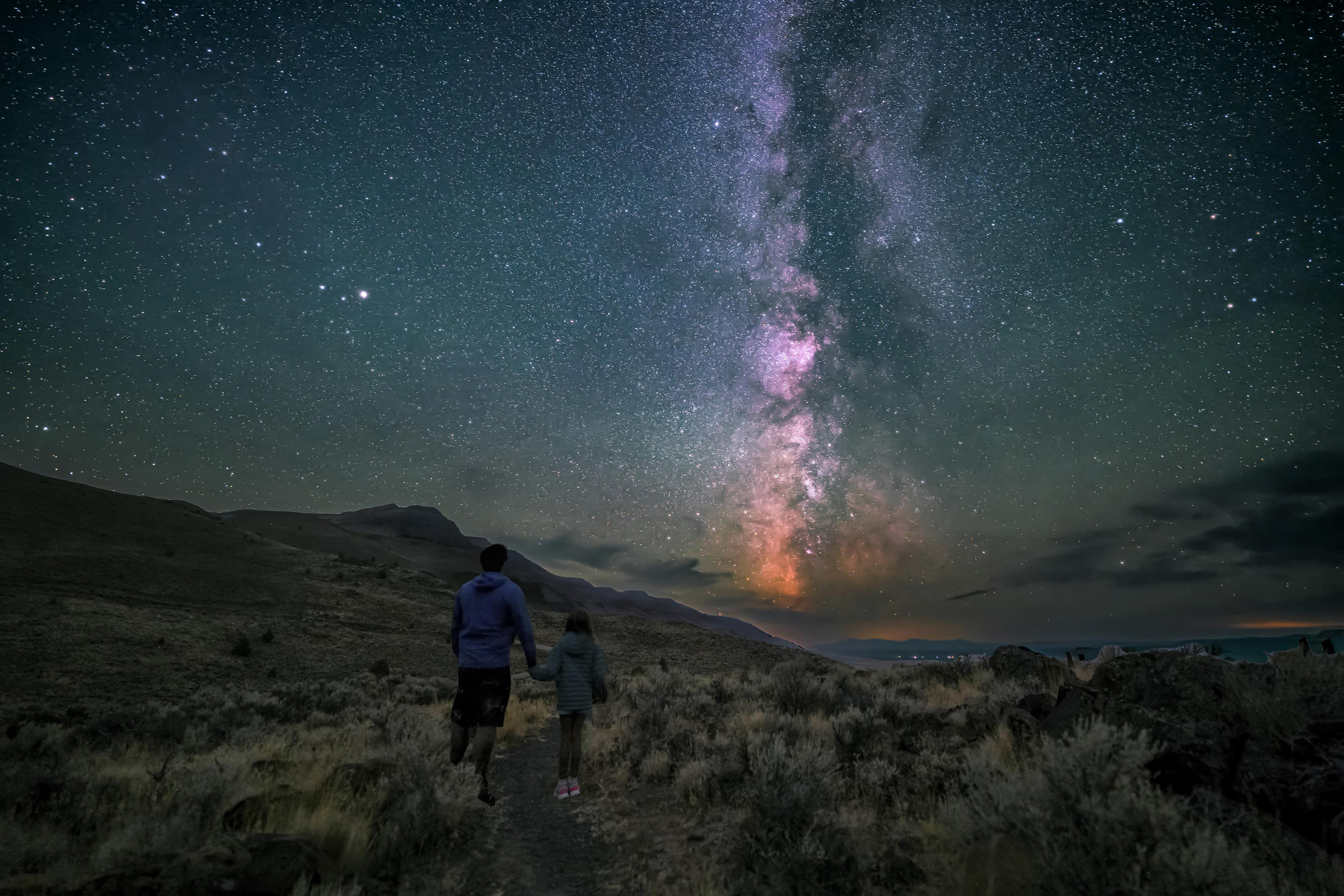
Southeastern Oregon Is Now Home to the World’s Largest 'Dark Sky Sanctuary'
04/26/2024 By Rebecca Jacobson
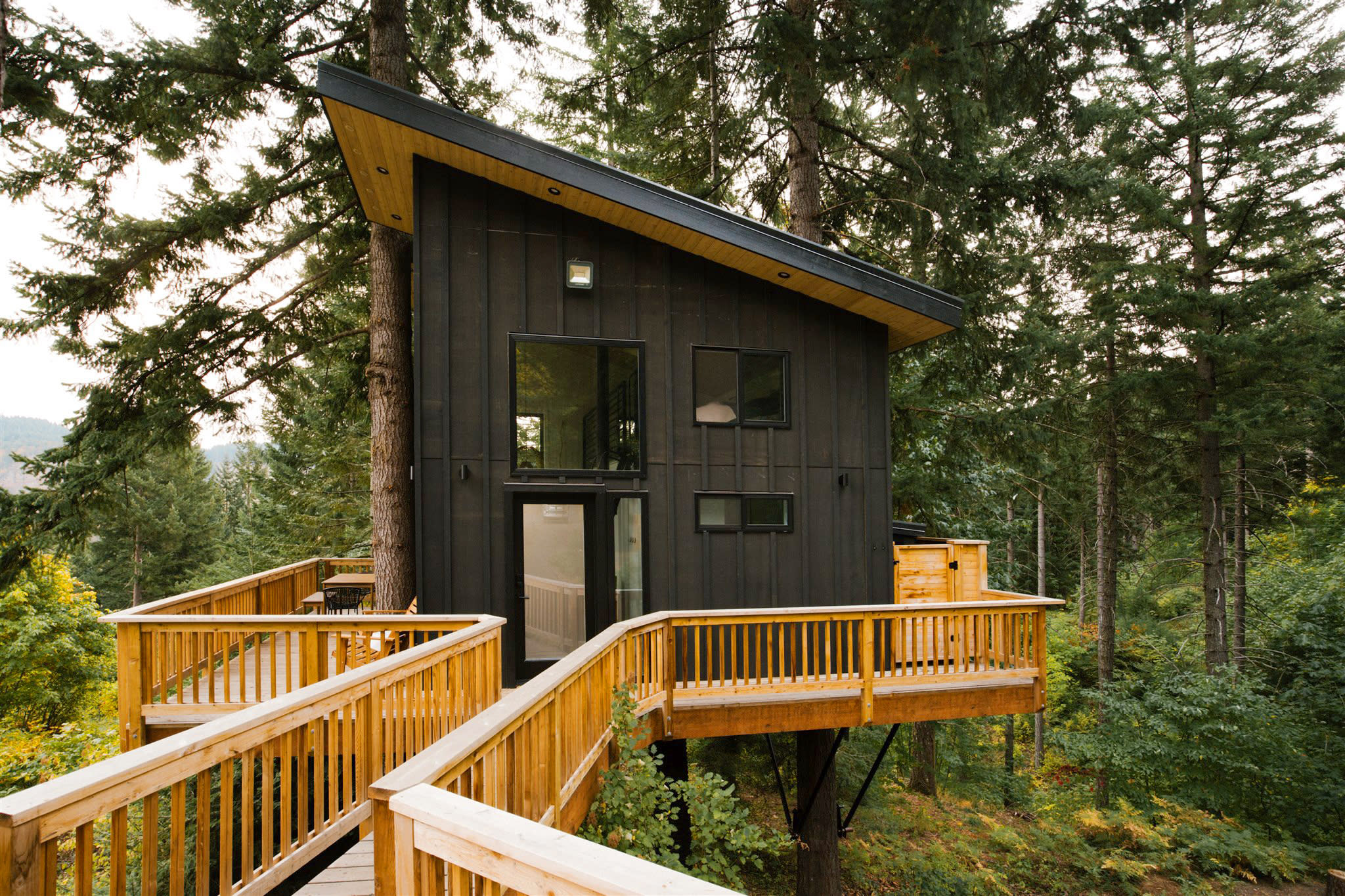
Rent a Roost
6 Pacific Northwest Treehouse Rentals for a Sky-High Getaway
05/14/2024 By Rebecca Jacobson

What to Do in Oregon in April
03/28/2024 By Portland Monthly Staff

U.S. Department of Transportation Federal Highway Administration 1200 New Jersey Avenue, SE Washington, DC 20590 202-366-4000
- Briefing Room
- Search FHWA
- Highway History
- Interstate System
- Federal-Aid Legislation
- History of FHWA
- General Highway History
Back in Time
Wagons west.
By Rickie Longfellow
We do not find an unpaved road these days easily, and when we do it is usually covered in gravel, and in many cases located in a campground.
Camping has become one of the fastest growing pastimes in our country today. But for many, camping does not include pitching a tent, fishing for dinner or otherwise roughing it. A new kind of camping has been sweeping America for decades and becomes more and more popular each year. It is referred to as RVing (Recreational Vehicle-ing). Often fueled by married couples earning double incomes, these comfortable motor homes, exclusive travel trailers, convenient and compact cab-over campers, converted vans and pop-ups, and eloquent Fifth Wheels hit our nation's roadways by the thousands, every day of the year. Running water, furnaces and air-conditioning, microwaves, dual televisions, bathrooms, kitchens and queen-sized beds are only a few of the standards in an RV. These adventurous travelers enjoy their RVs on smooth surface roadways, encountering only an occasional pothole or other roadway obstacle.
However, the Nation's first "campers"-the pioneers who migrated west by covered wagon train in the early to late 1800s-did not have today's luxuries and travel was not quite so easy. Aside from the rough journey of traveling by oxen-pulled wagon and walking great distances, travel was slow, and roads that were only rough dirt pathsto begin with often ended abruptly and detours were needed. Although pioneers did not have to pay the high cost of gasoline, they did have the challenge of keeping themselves and their livestock alive-particularly the oxen that pulled the wagons.
Time was another important factor in wagon train journeys, as settlers tried to reach their destinations before winter. We enjoy a coast-to-coast drive within a few days, with our RVs temperature controlled. The covered wagon made 8 to 20 miles per day depending upon weather, roadway conditions and the health of the travelers. It could take up to six months or longer to reach their destination.
Nowadays, we travel hundreds of miles in a day concerned only with reaching the campground before dark so that electric and water can be hooked up during daylight.
Armed with digital cameras and laptops to download photographs, RVers enjoy and capture the scenery of their travels. In reading many of the pioneer's memoirs and diaries it is apparent that along with all their hardships, they also had an appreciation of scenic terrain and good weather.
A pioneer wrote in his diary in the early 1800s, ". . . Entered a beautiful valley. . .warm pleasant day. . ."
The pioneers' transportation problems were mostly caused by weather. Wet weather created mud and quicksand, and winds caused fallen trees and other calamities that slowed travel and the "race" to be settled before winter. Unfortunately, avoiding snow was not always possible.
Hot weather could also become a problem as more frequent water sources were required for both traveler and livestock, though sufficient water and grasses were needed in all weather for the animals when the wagon train stopped for the night.
Broken axles from ruts in the trails were a major problem, but many travelers brought along a spare, just as we are equipped with a spare tire. Without it, the wagon would be abandoned and other travelers would assist the family until the wagon train reached a town to purchase another.
Toll bridges of today, sturdy steel and concrete structures with routine maintenance, may cost us a few dollars per vehicle; however, some early entrepreneurs charged from $5.00 to $15.00 to cross man-made wooden bridges over rivers. The charge would cover only the wagon and team, so other livestock that the travelers owned, such as cows and spare oxen, would have to swim, many drowning in the process.
In April 2002, the Public Broadcasting Station showed Frontier House where three families lived the frontier life for five months. The DVDs of the program are available for sale or from your local library. The project, an educational mini-series filmed the families' daily lives and survival as 1883 settlers. Experience the bumpy covered wagon journey to their destination as we get a first hand look at how our ancestors traveled on primitive paths and roads, and often no roads at all.
Recommended links:
- http://www.pbs.org/wnet/frontierhouse/
- http://www.cyndislist.com/migration.htm#Wagon
More Information
- FHWA By Day
- Richard Weingroff Office of Infrastructure 202-366-4856 E-mail Richard Richard's Bio
Notes From The Frontier
- Oct 21, 2019
What Pioneers Packed to Go West
Updated: May 11, 2023
Pioneers packed like their lives depended on it, because they did!

Westering pioneers had many routes to choose from but the main ones were the Oregon, California, Sante Fe, and Mormon Trails. Whatever route they chose, many read guidebooks like Landsford Hastings’ 1845 “The Emigrant’s Guide to Oregon and California” or Captain Randolph Marcy’s 1859 “The Prairie Traveler: A Hand-Book for Overland Expeditions.” They offered advice on what and how to pack, what draft animals to buy, distances, water, grass, terrain, weather, firearms and ammunition, tools, wagon parts, how to make repairs, and what hardships they might meet along the way.

Two primary types of wagons were used on wagon trails going west. The Conestoga wagon was named for Conestoga Township in Pennsylvania where many German pioneers in the 1750s first started West on the Appalachian Trail to settle land east of the Mississippi. It was a huge and very heavy wagon, 28 feet long with wheels five feet tall and, loaded, could weigh as much as six tons and took three pair of oxen to pull. (Like pulling a semi!)
Later, the much smaller Prairie Schooner became most common on the Oregon, California and Sante Fe Trails to the Western frontier. It was usually built in the Midwest for the departure points in Missouri, where all three trails started. The prairie schooner was half the size of the Conestoga, 12-13 feet long, and weighed 1,300 pounds empty and as much as two tons loaded. It required less animals to pull and to feed on the trail and could move faster (20 miles a day vs. 13-15 for the Conestoga wagon).

The sides of the wagons were waterproofed with tar, so they could ford rivers and keep the cargo dry. A thoroughly water-proofed wagon would also float in high water, making the crossing much easier. The canvas tops were oiled to keep out the rain. Wooden wheels had iron rims to prevent wear.
The Oregon Trail took roughly four to six months to complete. Packing could mean the difference between life and death on the trail and varied wildly depending upon the sensibilities (and sometimes the sense!) of the travelers. James Miller’s 1848 diary entry describes what they packed for food: “We had… 200 lbs. flour for each person, 100 lbs. bacon, corn meal, dried apples and peaches, beans, salt, pepper, rice, tea, coffee, sugar, and many smaller articles for such a trip.” Pioneers also commonly packed 80 lbs. lard, 20 lbs. sugar, 10 lbs. each of coffee and salt per person, yeast, hardtack and crackers.

A wagon was filled with essentials, so travelers usually walked alongside the wagons. This also saved the energy of the oxen, mules or horses pulling the wagons. Teams grazed at night for grass.
Some travelers brought cattle to butcher along the way. Many brought a milk cow and a chicken or two for eggs. Each morning, after milking the cow, the buckets of milk were covered and hung under the wagon. The jarring of the unsprung axle would churn the milk! At night, the fresh butter would be skimmed off. A Dutch oven was the standard cooking container because it was versatile and could be used to bake bread, cook soups, grill meat, and make oatmeal in the morning.
Most wagons had a “chuck box” at the back of the wagon that consisted of a fold-down table surface in front of a cabinet that contained food stuffs, utensils, plates and basics needed to prepare a meal. Shelving below the axle contained larger Dutch ovens, bowls for making bread dough, tubs for washing, or even bottles of a more sundry nature.

Large wooden water kegs were carried on the sides of the wagons. Water would be resupplied from rivers along the way. However, there were some dry stretches and water was carefully preserved. Cholera epidemics were most common along the Platte River and were caused by contaminated water from the massive numbers of travelers that bivouacked there.
Medical and surgical supplies were essential: bandages, ointment, laudanum, cough syrups that contained cocaine, painkillers that contained opium, and of course alcohol for drinking. (Alcohol as an antiseptic was not commonly used until the 1890s.) Surgical instruments for suturing wounds, pulling teeth, lancing boils, extracting bullets or arrowheads, and a bone saw for amputating were commonly packed as well.
Tools for repairing or rebuilding wheels, axles, wagons, ox bows, and harnesses were heavy but crucial to have. The basics were hammers, saws, augers and gimlets. Prudent planners would also pack heavy rope, chains, spare parts, axle grease, and even pulleys. Oil and candle lanterns were essential since work and repairs often had to be done at night, so all would be ready when the wagon train left in the morning.
Warm clothing for rain and cold was packed, as was bedding. Although bedding took up space, it was crucial to get as much sleep as possible. Travelers walked about 20 miles a day over often rough terrain, or in prairie grass as tall as they were, and were exhausted at the end of each day.

Those who insisted on packing iron stoves, heavy furniture, pianos, sewing machines, iron plows, kegs of whiskey, blacksmith anvils, or other weighty items usually discarded them on the side of the trail as the grazing and water ran out. Fort Laramie in Wyoming became known as “Camp Sacrifice” because it was so littered with jettisoned cargo, antique furniture and family heirlooms, chests of silver and china, stoves, and pianos, broken wagons, and dead animals.
Most wagon trains had at least 25 wagons. Perhaps the largest wagon train to travel on the Oregon Trail left Missouri in 1843 with over 100 wagons, 1,000 men, women and children, and 5,000 head of oxen and cattle. The train was led by a Methodist missionary named Dr. Elijah White. But wagon trains became so common on the trail that processions seemed to have no beginning or end. Diaries told of hundreds of wagons passing by Fort Laramie in a single day in the 1850s. Foraging for the teams became a serious challenge because grazing near the trail had been exhausted.
Two posts from the pioneer diary of Elizabeth J. Goltra provide a glimpse of traveling on the trail:

September 20, 1853: Two of our horses are missing this morning. Bought 30 pounds of beef and some other eatables… found plenty of wood and water and grass one mile south. We are now at the foot of the Cascades, in heavy timber. Bought 80 pounds of flour off an emigrant at 10¢ per pound. We now have plenty of provisions to last us through. We guard our cattle very closely or we would lose them in the timber. Rest the remainder of the day to let the cattle eat plenty for feed is scarce in the mountains.
September 24, 1853: This is a very rainy morning. The roads are very bad. Fearful of being caught in a snowstorm… This is the roughest and steepest hill on the road. Got down all safe by cutting and chaining a tree behind the wagon 100 feet long. Camped at the foot of the hill and tied our stock up with nothing to eat but a little grass we carried along with us.

PHOTOS: (1) Conestoga wagons were used early in pioneer history to travel on the Appalachian Trail and east of the Mississippi. But they were extremely heavy—up to six tons loaded--and required up to six animals, usually oxen, to pull. (2) The smaller Prairie Schooner started to replace the larger Connestoga wagons and were often built in the Midwest near the starting point of the Oregon Trail. (3) Two families rest at the end of the day on the trail at the foothills of the Rockies in northern Utah,1870. Photograph by Henry Martinean. Denver Public Library. (4) A very rare photograph of the inside of a covered wagon packed for the Oregon Trail shows the crowded quarters. (5) Custer’s Black Hills Expedition of 1874 included 110 covered wagons, 1,200 men, artillery and food supply for two months. This expedition was about the same size as the largest wagon train ever to travel the Oregon Trail.
You may also enjoy these related posts:
-What Pioneers Ate
https://www.notesfromthefrontier.com/post/what-pioneers-ate
-Pioneer Survival Guides
https://www.notesfromthefrontier.com/post/pioneer-survival-guides-in-the-1800s
"What Pioneers Packed" was originally posted on Facebook and NotesfromtheFrontier.com on June 24, 2019
513,667 views / 23,754 likes / 14,767 shares / 676 comments
© 2021 NOTES FROM THE FRONTIER
- Homesteading Life
- Most Popular
Thank you for this wonderful and detailed post. the photos and drawings are awesome and so helpful in research.
Thank you, Gini❣️
I really enjoyed this article! I’m always fascinated with American pioneer history!!
Great article and photos. Much appreciated. Really brought out what hardships they faced and what was needed to survive them. Interesting re: food supplies.
Thanks for your question, Jim. I can’t answer your question off the top of my head, but I do know that reliable wagon masters were a rare breed and a very valuable commodity! Many had worked the fur trade or been Indian scouts. This would make an excellent post in the future! Look for it. Thanks again.
Any recollection of a Peter Purrier as a wagon master? Approximately how many “reliable” wagon masters were there. Thanks Jim Wheeler
Deborah Hufford
Author, Notes from the Frontier
Deborah Hufford is an award-winning author and magazine editor with a passion for history. Her popular NotesfromtheFrontier.com blog with 100,000+ readers has led to an upcoming novel ! Growing up as an Iowa farmgirl, rodeo queen and voracious reader, her love of land, lore and literature fired her writing muse. With a Bachelor's in English and Master's in Journalism from the University of Iowa , she taught students of Iowa's Writer's Workshop , then at Northwestern University , Marquette and Mount Mary . Her extensive publishing career began at Better Homes & Gardens , includes credits in New York Times Magazine , New York Times , Connoisseur , many other titles, and serving as publisher of The Writer's Handbook .
Deeply devoted to social justice, especially for veterans, women, and Native Americans, she has served on boards and donated her fundraising skills to Chief Joseph Foundation , Missing & Murdered Indigenous Women ( MMIW ), Homeless Veterans Initiative , Humane Society , and other nonprofits.
Deborah's soon-to-be released historical novel, BLOOD TO RUBIES weaves indigenous and pioneer history, strong women and clashing worlds into a sweeping saga praised by NYT bestselling authors as "crushing," "rhapsodic," "gritty," and "sensuous." Purchase BLOOD TO RUBIES online beginning June 9. Connect with Deborah on DeborahHufford.com , Facebook , and Instagram .

- Search Please fill out this field.
- Manage Your Subscription
- Give a Gift Subscription
- Newsletters
- Sweepstakes
- Hotels + Resorts
- Vacation Rentals
Travel Across 25 U.S. States and Stay in a Modern-day Oregon Trail-style Covered Wagon
Conestoga wagons are available at resorts in 25 U.S. states.
Jessica Poitevien is an international storyteller and regular contributor to Travel + Leisure.
:max_bytes(150000):strip_icc():format(webp)/Jessica-Poitevien-2cbdf969757d480cb8b287cf97d1b882.jpg)
If you've ever played the Oregon Trail computer game and wanted to experience life in one of the wagons that brought the settlers West, now's your chance. The Conestoga Wagon Company has a new network of resorts featuring its iconic wagons, so you can have all the pioneering fun minus the rattlesnakes and dysentery.
With covered Conestoga wagons available at properties in 25 U.S. states, travelers can create their own adventure, starting as far east as Maine until they reach the westernmost Conestoga location, appropriately set in Oregon . Other Conestoga wagons can be found at resorts in Florida, Texas, Montana, Arizona, Washington, and Colorado, among others. Some locations are also ideal for exploring National Park Service sites like California's Frandy Park Campground near Sequoia National Forest and North Carolina's Iron Horse Motorcycle Lodge & Resort near Nantahala National Forest.
Conestoga wagons offer sleeping arrangements for up to six people, with the choice of king-size, bunk, or single twin bed configurations. And though they harken back to the old days, these wagons come with all the comforts of the 21st century. Guests can expect to find built-in USB ports and optional tables perfect for creating a workcation space, plus a mini fridge, microwave, and coffee maker. The well-insulated wagons can also be equipped with air-conditioning and heaters to keep temperatures inside regulated.
The company has sold over 375 wagons since its launch in 2015, and while the exact features of each depend on the resort's management team, these properties certainly have plenty of options to create a unique experience. Resorts have been known to host campfires, sing-alongs, and meals reminiscent of the early days of cross-country travel. Properties with several wagons and plenty of space can even shuffle things around to create a "circle the wagons" experience for families or groups traveling together.
The Conestoga Wagon Company has also expanded its offerings to include shower houses and luxury tents complete with claw-foot tubs and full wooden vanities. For more information about purchasing any of these products, or to plan a Conestoga wagon vacation, visit the company's official website here .
Jessica Poitevien is a Travel + Leisure contributor currently based in South Florida, but she's always on the lookout for her next adventure. Besides traveling, she loves baking, talking to strangers, and taking long walks on the beach. Follow her adventures on Instagram .
Related Articles

click links below for booking a trek
wagon train things to do in casper wyoming.

Book Your Historic Trails Experience May - October
Call 1(307) 266-4868

Five Day Historic Wagon Train and horse ride to So pass.
Yellowstone 1883 Wagon Train is like our Five day Covered Wagon Trek.
You are riding on Historic Wooden Wheel Wagons that have been on the Oregon and California Trails.
A trail of excitement, hope and challenge.
A trail of real life and death.
A trail of great achievement and disappointment.
A trail of the stories of those who traveled the trails.
The Trail of America and Her People
We head out for your Historic Trails West Wagon Train adventure from Casper, Wyoming. On the drive past Split Rock, much of the highway follows the old trail systems. You will see old Pony Express and Outpost sites and trail crossings as we wind through gorgeous mountains and cross through the high plains. Along the way we will tour the famous Independence Rock where pioneers scratched their names into this famous landmark.
Day One : Your first day on the trail you learn how the pioneers prepared for the journey, what foods and supplies they packed, the animals they used, how to harness the teams to the wagon and more! Following along on your trail map, you will become absorbed into the intimate details of the trail as you travel in the footsteps of the Homesteader, the Mormons, the 49ers, and even the Natives of the west! Just like the pioneers, you pitch in to set up camp and help unharness the animals. Learning how to put up your own tepee sleeping lodge is a treat! As you settle in to life on the trail, enjoy a special evening with the trail cook learning secrets of Dutch Oven Cooking in preparation for the night's amazing dinner cooked over the open fire.
Day Two : Your second day on the trail, you learn about life on the trail, come to know the rules of a wagon train, watch for herds of antelope, hear tales of the mighty buffalo, and ford the 6th crossing of the Sweetwater River! Traveling in the actual ruts of the original trails, we slowly wind our way through high plains and hills and arrive at our camp by Silver Creek. You will join the camp cook for a peek at the old trail foods and how they were prepared! We eat a bit better than they would have but you will love the Dutch Oven and skillet cooked campfire cuisine dished up every night and morning! The sun sets on the day as we settle around the crackling campfire for cobbler, and hear suspenseful stories of the old west. Day Three : After a hearty breakfast, we break and load up camp, hitch the teams, saddle the horses and continue our journey west. This day, places written about in pioneer journal entries come into view. We visit places of suffering for the Martin and Willie Handcart Companies and see the tailings of private gold mines that bring stories of the California Gold Rush to life. We pull up in front of the old Pony Express Station at Radium Springs for lunch. The whole way, we travel in the footsteps of famous mountain men like Jim Bridger and Bill Sublette as the majestic Wind River Mountains watch over us. Arriving in our camp for the night we set up and learn some of the skills needed to be a 49er, a mountain man, or a Settler! Help the cook at the fire or some other life talent of the Old West! Settle in to your lodge and, relax to the sound of the wind rustling through the cottonwood trees. In the middle of the night you may hear the eternal song of the prairie sung by the yipping coyote as he welcomes you to his homeland. Day Four : After another hearty breakfast and making all things ready to get on the trail, we head into the Old South Pass Area, which is an amazing treasure of old mines and historic buildings. That evening we camp at the 9th crossing of the Sweetwater River. The site of the old South Pass Fort is nearND pioneer graves. The Pony Express once made way through here.
Where there is good water there are many stories. Around the fire we come to terms as to where we are in the journey, and how even the boundaries of the United States were different in that day. As we settle into the last night in our lodge, you realize how very close you are to the Old Oregon Country. Will you make it? Only tomorrow will you know with the rising of the sun and heading out again on the trail. Day 5 : After 4 days on the trail making your way
across multiple river crossings and creeks through the wide open prairie and through foothills over Rocky Ridge, past places of tragedy and triumph, we finally make it to Oregon Country.
You will have seen wildlife
You will have passed pioneer graves.
You will have traveled the places of Natives of long ago.
You will have changed in the journey.
You will take along with you memories in vivid detail, a new appreciation for many things both yesterday and today, a better understanding of how America became America, who the pioneers really were and why they tried to make the journey and who you now are, having been, on such an incredible journey into the past.
On Historic Trails West Living History Wagon Train.
As a pony express rider you will ride along side the wagon and may switch off with who you choose.
We provide, sleeping bags (unless you are bringing your own), foam pads, air mattresses, or cots. Pricing includes individual meals.
Porta Johns are in support vehicle at each camp site and intersecting wagon train along the trail on some of the days.
On the trips, where possible, you can use solar showers, if requested.
The route and campsites may change due to weather or other situations ,FOR THE SAFETY OF THE GUESTS AND ANIMALS
Five Day Historic Wagon Train and horse ride Pricing:
Adult $1,595.00 per person in the wagon
Child $1,095.00(10 Yrs and under) per person in the wagon
Five Day "Pony Express" Rider Pricing: Adult $1,895.00 per person
You can trade off with people in your party riding booking a horse.
We charge a 3.5% card fee.
Please call to book and you can send a check if you like
The route and campsites may change due to weather or other situations, FOR THE SAFETY OF THE GUESTS AND ANIMALS.
The average elevation of our camps on the 3- and 5-day treks are over 7,000 feet. Days can be hot and nights can be cool, weather can change in the blink of an eye. The weather might change route of travel if storms make travel on trails impossible. For this reason, "think in layers" of clothing.
Items you should bring include: Water bottle Bring along electrolyte’s for your journey. Filled Water Bottle Light and Heavy Jackets, Long and Short Sleeved Shirts, Good hiking shoes, Extra Socks Rain coats, Long Pants, Casual Shoes for in Camp, Hat, Bug Repellent Camera with extra batteries, Flashlight, head lamp light, Granola/Trail Mix, Small first aid kit. Everyone will set up camp and take down. Help with all chores. 1-307-266-4868 to Book, or e-mail [email protected]
What was it like to travel in a covered wagon?
EDMOND — An authentic wagon from the 1889 Land Run will be making a two-day visit to the Edmond Historical Society & Museum.
Visitors will have two opportunities to view and climb inside the wagon for photographs on Tuesday or March 17.
The public may visit the wagon from 2 to 4 p.m. on either day. A staff person will be on hand to share information and assist with taking photographs. A suggested donation is $2 per person, according to a news release.
The wagon will be stationed outside the historic Rodkey House, 410 S Littler Ave., west of the museum at Stephenson Park. Visitors will need to be physically able to climb into the wagon without assistance, the news release stated. The Rodkey House from 1901 also will be available to tour during this time. Visitors are asked to wear masks while interacting with museum staff.
The museum also will be offering a children’s camp, “Covered Wagon Courage and Conundrums,” from 9 a.m. to 2 p.m. March 16 or March 17. Children can discover what it was like to travel West by covered wagon. Those attending will investigate the features of the covered wagon, and learn how to pack for a long journey, and how pioneers cooked, slept, dressed and played during their travels.
The camp is for ages 6 to 12 and limited to 12 campers per day. COVID-19 precautions will be taken. The cost per camp day is $35. Campers will meet at the Rodkey House. Reservations are required. To sign up, go to https://tinyurl.com/j3k2hjc3 .
The wagon event is sponsored by Bob and Kathy Thomas, with special thanks to Carol Anderson and Studio Z, a museum release stated.
The Edmond Historical Society & Museum is open from 10 to 4:30 p.m. Tuesdays through Fridays and 1 to 4 p.m. Saturdays at 431 S Boulevard. Admission is free, and masks are required. For more information about the museum, go to www.edmondhistory.org or by call 405-340-0078.

How Fast & Far Can a Horse-Drawn Carriage Travel?
By: Author Anna Stanek
Posted on Last updated: 09/19/2021
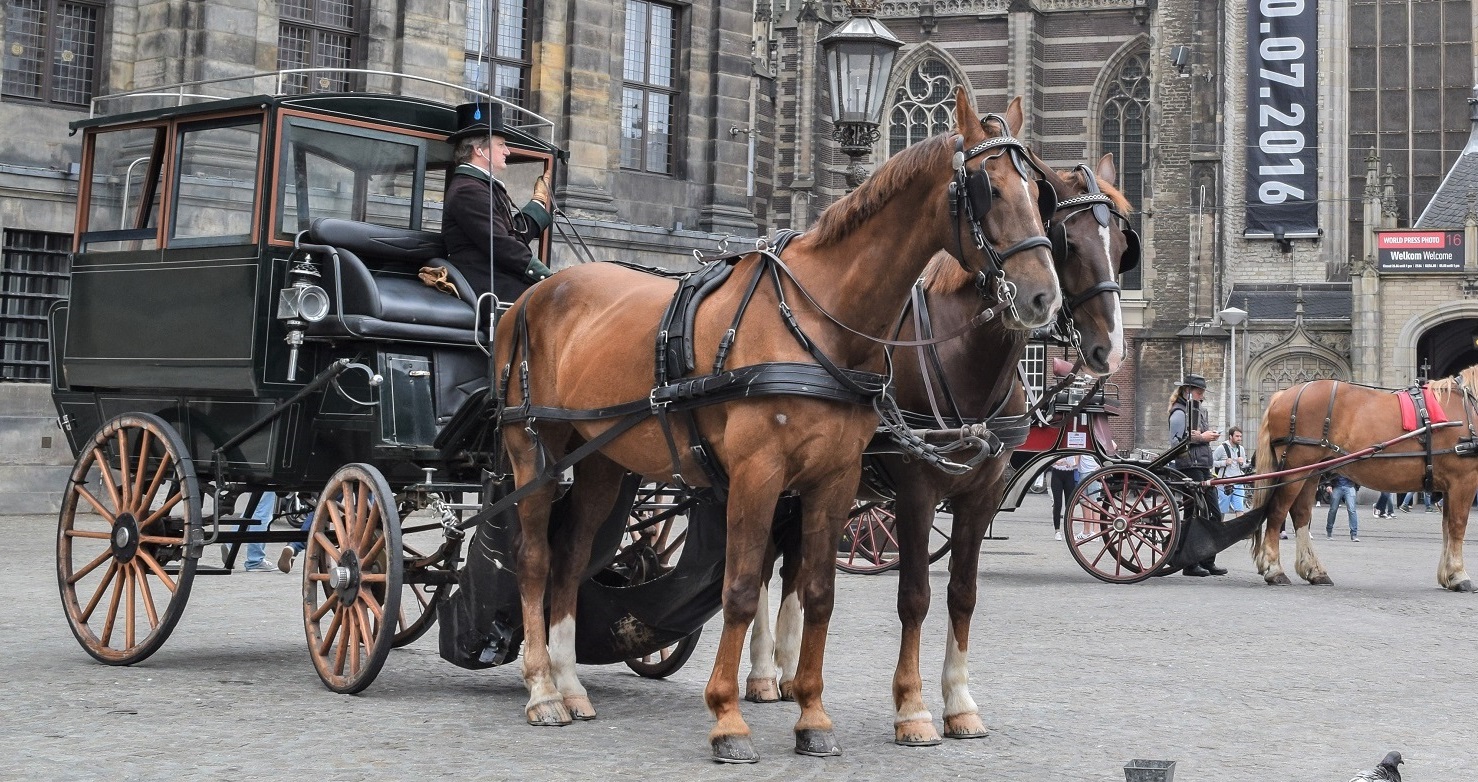
This post may contain affiliate links. We earn from qualifying purchases. Learn More
For thousands of years, horses have been used for transportation. Horse-drawn carriages have allowed for travel that otherwise would have been very difficult or even impossible for people.
Though cars have taken over as the main source of transportation, horse-drawn wagons are still used in some parts of the world for transportation and work. In addition, horse-drawn carriages are popular today for leisure and competition.
How Fast Does a Horse-Drawn Carriage Go?
At a trot, a horse-drawn carriage will go around 8-10 MPH. At a walk, a horse-drawn carriage will go about 2-4 MPH. The speed of a carriage depends on the weather, terrain, horse, and other tractors.
Generally, horses do not canter or gallop with a carriage. Though in movies you will often see horses galloping with wagons, it is not common in real life. Cantering or galloping with a carriage or wagon can be dangerous and it is also a lot more work for a horse.
In some cases, however, rodeos will host chuckwagon races. In chuckwagon races, a hitch of two to four horses race on a track, normally for half a mile. However, the sport has faced controversy as it is dangerous and has led to the death of several horses over the years.
When at the canter, a horse-drawn carriage goes approximately 10-15 MPH. At the gallop, the speed will be around 18-25 MPH.
How Far Can a Horse-Drawn Wagon Travel in a Day?
On average, a horse-drawn carriage can travel between 10-30 miles a day. The distance will depend on factors such as terrain, weather, horse, and weight of the carriage.
In hot weather, a horse’s workload should be reduced in order to prevent overheating. When the humidity and temperature add up to 150-160, a horse should only do light work. This means they should generally only travel ten miles or less in a day. When the humidity and temperature add up to 160 or over, a horse should not work.
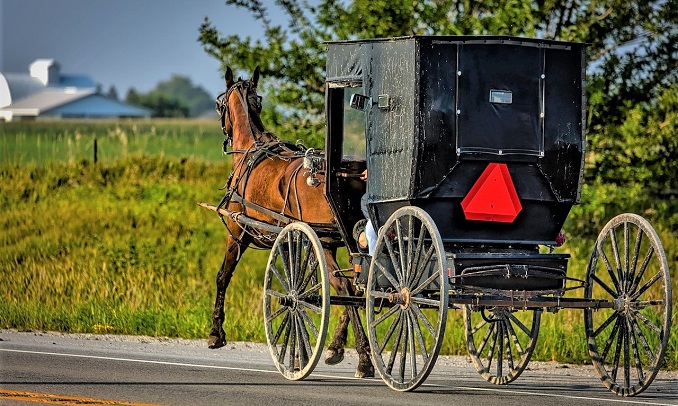
If a horse is traveling across hilly, uneven terrain, it will be more challenging for them to pull a wagon. Though on flat terrain they will be able to up to 30 miles or even more, they won’t be able to travel that far in a day over rough terrain.
Weight is another aspect that will affect how far a horse can travel in a day. Though horses are capable of pulling thousands of pounds over short distances, they won’t be able to pull that much weight across several miles. Horses will have no problem pulling a few hundred pounds to even a couple of thousand pounds, depending on their size. However, any more than that will be difficult over longer distances.
How Much Weight Can a Horse Pull?
A horse on average can pull 1.5 times its body weight over a long distance with a carriage. When traveling a shorter distance, they are capable of pulling three times their body weight.
On average, a 1,000-pound horse can pull 1,500 pounds across long distances. Across shorter distances, a 1,000-pound horse has the ability to pull up to 3,000 pounds.
Horses are also able to pull more together than they can apart. Two horses are capable of pulling up to three times the amount of weight they could by themselves. So, a draft horse that could pull 6,000 pounds by itself would be able to pull up 18,000 pounds with another horse across a short distance.
In pulling competitions, draft horses have been known to pull 10 to 15 times their body weight. Though they wouldn’t be able to keep this up over long distances, it is still very impressive.
In 1924, a pair of Shire horses set a world record by pulling a whopping 100,000 pounds. That same year, a single Shire defied the odds and pulled 58,000. Talk about some truly astounding horsepower!
More recently in 2012, a team of Belgian draft horses broke the record at the world-famous Calgary Stampede’s Heavy Horse Pull by pulling a deadweight of 13,400 pounds. Then, in 2014, another pair of Belgians at the National Western Stock Show wowed the audience by pulling a staggering 17,000 pounds.

What Breeds of Horses are Used for Carriage Driving?
Draft horses are popular choices for carriage driving. Their sturdy builds allow them to pull heavy loads. In addition, their calm dispositions make them reliable horses. Draft breeds such as Belgians, Percherons, Clydesdales and Shires are all great breeds for driving.
In addition, there are many other horse and pony breeds that excel at driving. These breeds include the Friesian, Morgan, Hackney, Dutch Harness Horse, Gypsy Vanner, Welsh, Haflinger, Cleveland Bay and Saddlebred. However, with the right training, just about any breed can excel in driving.
Types of Carriages, Wagons and Carts
There are many types of horse-drawn carriages, wagons and carts that can have two or four wheels. The most common ones are Barouche, Hackney Coach, Stagecoach, Meadowbrook, Pleasure Cart, Fine Harness Buggy, Landau, and Prairie Schooner.
A Barouche is a four-wheeled open carriage that is often pulled by one or two horses. It has a heavy, luxurious build that holds at least four people and often features a collapsible half-hood. The style is common among carriage ride companies today.
Hackney Coach
Hackney coaches are one of the first types of horse-drawn carriages that traditionally people would keep for hire. They are an enclosed four-wheeled carriage that includes seating for four to six people with a simple design. They often have a hitch of two or four horses.
Stagecoaches are most recognizable from old western movies and TV shows. Originally for public transportation, these large, heavy carriages have four wheels. They often consist of a two, four or six-horse hitch.
Meadowbrook
A Meadowbrook cart is a two-wheeled open carriage, that features large wheels. They include two seats, where one seat folds for rear entry and is pulled by one horse. Today, they are commonly used for carriage driving competitions and pleasure driving.
Pleasure Cart
Pleasure carts are two-wheeled vehicles that are pulled by a single horse. They have a simple design and can seat two people. They are a popular choice for horse shows.
Fine Harness Buggy
A fine harness buggy is a four-wheeled vehicle that sits one person. They have a simple yet elegant design. They are used especially for horse shows.
A Landau is a four-wheeled carriage that has a collapsible, full-coverage roof. They are often luxurious in style and have long been a popular choice among royalty. They generally have seating for four to six people and have a two or four-horse hitch.
Prairie Schooner
Prairie Schooners, also known simply as covered wagons, were pioneers’ main form of transportation while traveling across the American West. They have four wheels and a cotton canvas cover. Covered wagons are spacious, with room to hold several people and large amounts of supplies.
Hands-on geography activity maps kids & teachers
Products search

by Map of the Month
Call Us. 888-876-6277
No products in the cart.
- About Our Maps
- Printable Order Form
- US State Maps
- Countries & Regions
- Continents & World
- History & Specialty Maps
- Classroom Kits & Map Essentials
- Teaching Tips
- How to Draw a Compass Rose
- Earthworm University
- Finished Maps
First Covered Wagons reach California and Oregon in 1841
Geography Blog
0 comments
Early pioneers blazed many trails as they crossed our country to reach the west coast. The first covered wagon reached California after an exhausting and life-threatening trip of over 6 months!
In May of 1841, about 70 people set out from Independence, Missouri, in Conestoga-style wagons, heading towards the west coast. They were determined to be the first pioneers to cross the Rocky Mountains to reach the west coast. Although the famous Lewis and Clark Expedition had reached the Pacific Ocean in 1806, it was many years before the first wagon train reached California.
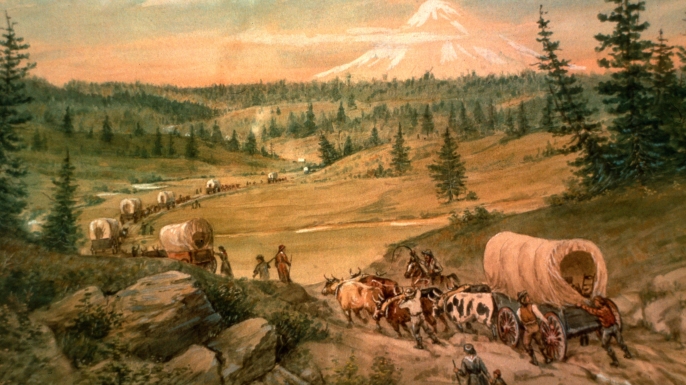
When this group reached Idaho, they broke in half. The first group headed to Oregon.
The second group set their goals on California, and after much hardship, they reached California on November 4th, 1841.
The travelers going west often encountered these life-threatening problems:
Running out of fresh water and food
Indian attacks
Guns misfiring
Pouring rain, hail, and death by lightning
Falling off horses or mules
Crushed by wagon wheels
Drowning in river crossings
Disease, such as flu, typhoid, dysentery, cholera
Overturned wagons due to rocky terrain
Runaway wagons on inclines
Abandoned wagon trains in desert areas
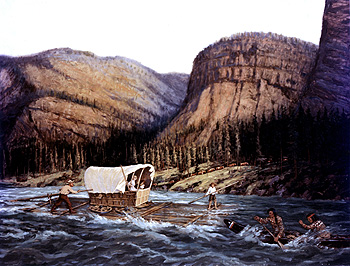
MAPPING THE TRAILS!
Here are some landmarks of the trails for each of those early groups that set out from Independence, Missouri. Encourage your students to find photos of these places, and describe the terrain.
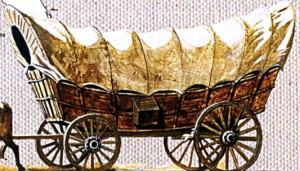
You can have them mark a map, like our TRAILS WEST map , which shows all the major routes that crossed our country.
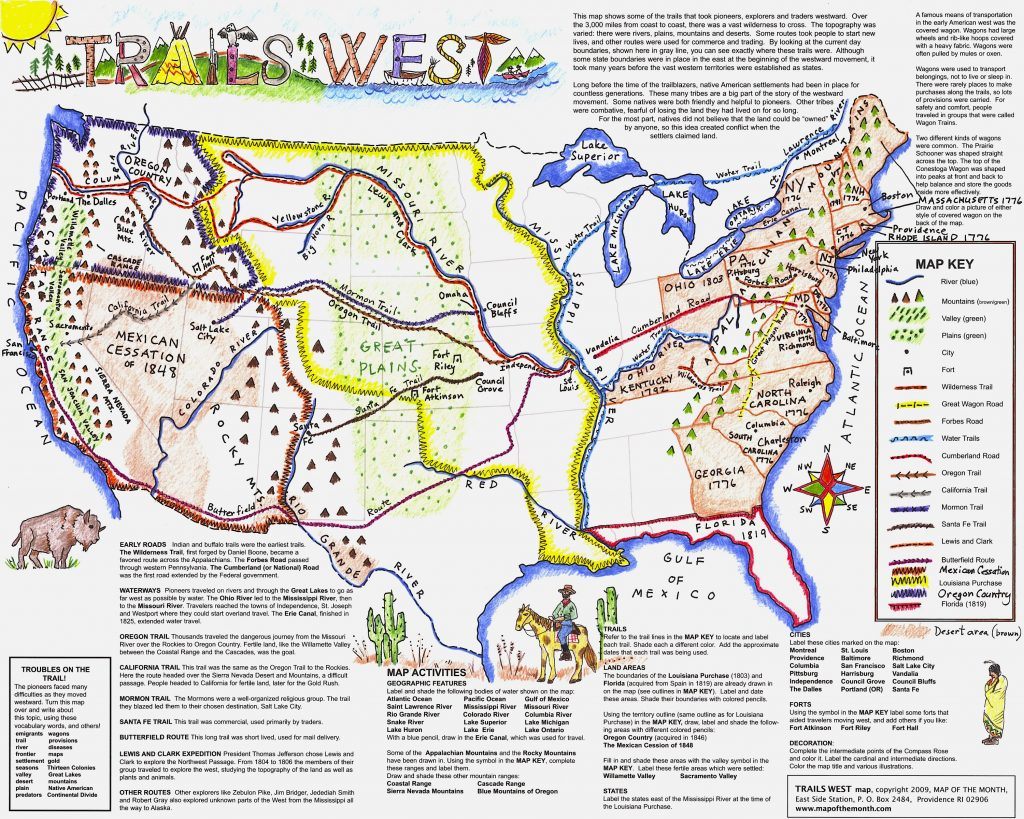
Click this image above to see this map in more detail, or see the map HERE !
FIRST WAGON TRAIN TO REACH CALIFORNIA
The settlers heading to California had to Cross the Sierra Nevada Mountains before reaching of Tuolumne County in California. Their route, after leaving Missouri, went like this:
Followed the north shore of the Great Salt Lake
Reached Mary’s River now called the Humbolt River
Traveled to what is now Lovelock Nevada
Followed the Walker River
Crossed the Sierra Nevada Mountains
Reached the area around Mount Diablo, California
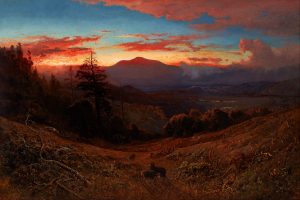
FIRST OREGON SETTLERS
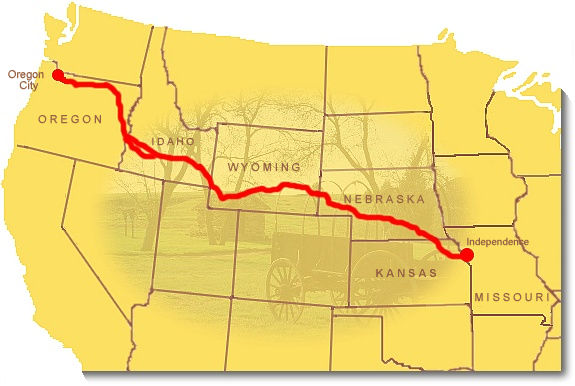
The other group of Oregon settlers took a 2,000 mile route. This trail that became known as the “Oregon Trail”.
This is a condensed list of landmarks along their trail:
Started on the banks of the Missouri River
Crossed the land of Kansas
Crossed the southern Sand Hills in southern Nebraska.
Followed the south shore of the Platte River
Passed through southern Wyoming
Crossed mountains to the Great Divide Basin
Passed through the Rocky Mountains via the South Pass in Wyoming
Followed the Snake River (now southern Idaho)
Crossed the Blue Mountains
Worked across land and mountains northwest to the Columbia River
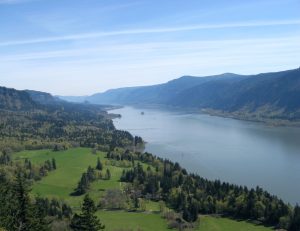
OTHER RELATED RESOURCES
For more maps to share with your students, see this link from the National Park Service.
Firsthand written accounts of taking the Oregon Trail HERE .
See our popular TRAILS WEST map HERE !
See our USA, Regions of Native American Culture map HERE !
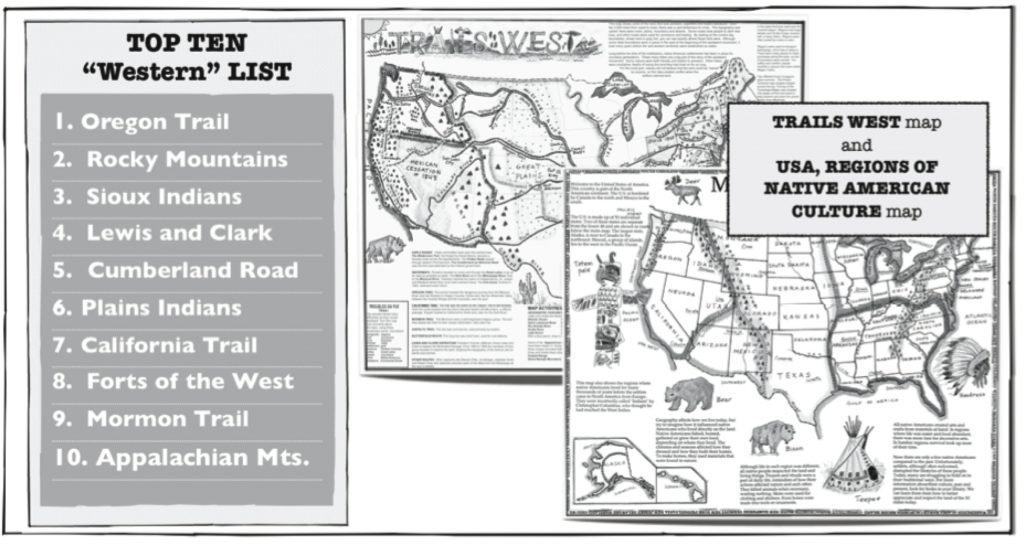
california, covered wagons, oregon trail, trails west
You may also like
New usa– five regions, five maps videos to help, too, videos to go along with our maps — for class or remote learning.
Session expired
Please log in again. The login page will open in a new tab. After logging in you can close it and return to this page.
- Scenic Excursions

- One Day Excursions
- Multi-Day Excursions
- Groups of 30+
- World Travel

Charters & More
- Buffalo Niagara Office
- Souther Tier NY/NW PA Office
- Did You Know?

Departure Points
- {AV} Avon Scenic Excursions
- {CA} Canandaigua Park & Ride
- {DA} Dansville Tractor Supply
- {HE} Henrietta Winton Place
- {HH} Horseheads Jubilee
- {HO} Hornell Wegmans
- {LE} LeRoy Park & Ride
- {PE} Perinton Recreation
- {PP} Painted Post Former Ames

- Book Early & SAVE!
- Experience Casinos
- Guaranteed Departures
- Double Dollars
- New Excursions
- Gift Certificates

Excursion Information
- Crossing into Canada
- Excursion Evaluation
- terms & conditions
- Travel Dollars
- Travel Protection Plan

Booking Summary
Recently added excursions:.
Your Booking Cart is empty.
FEATURED EXCURSIONS
Book early & save.

NYC Holiday & Christmas Spectacular - December 14-15, 2024

NYC Holiday & Christmas Spectacular - December 16-17, 2024

NYC Holiday & Christmas Spectacular - December 7-8, 2024
Explore our catalog....

Top 6 Things to do at Scotts Bluff National Monument
T he Midwest is huge and it seems like it takes days to cross it, in a car with air-conditioning and entertainment. Consider crossing the midwest from east to west in a covered wagon with everything you own for a new life you’ve never seen. Or on horseback with enough food for a day. Located in the western side of Nebraska, Scotts Bluff National Monument is a 800-foot rock formation that’s been a beacon for centuries for migrating peoples. Visitors can learn about the rock formation along with the people that used it as a landmark. Here are the top things to do at Scotts Bluff National Monument.
Scotts Blufs at at Glance
Top things to do at scotts bluff.
Might be a quest to visit all 50 states, or you might be on your way to the Black Hills of South Dakota or Yellowstone National Park, either way Nebraska offers a great road trip stop.
- Head to the Visitor Center
- Learn about the People who used Scotts Bluff
- Take a Scenic Drive to the Summit
- Hike at Scotts Bluff
- Earn a Junior Ranger or BARK Ranger
- Have a Picnic
Discover More near Nebraska
Explore dodge city in kansas, visitor center at scotts bluff.
Inside the Visitor Cener find an interpretive area explaining the migration of 250,000 American pioneers that passed through this area from 1843 to 1869. The Visitor Center features a short film too.
William Henry Jackson is known as the first person to photograph Yellowstone National Park. He was born in Vermont though settled in Omaha, Nebraska, before joining the Hayden Geologic Survey of Yellowstone in 1871. The largest collection of his sketches, photographs and paintings.
The visitor center is open daily from 8 a.m. 6 p.m. in the summer from late May until late August. For the rest of the year, it is open from 8:30 a.m. to 4:30 p.m. It is located at 190276 Old Oregon Trail Road.
Planning Guide to Yellowstone National Park
What’s scotts bluff .
With 3,000 acres to explore, Scotts Bluff National Monument protects the remnants of the overland trail ruts, badland formations and Scotts Bluff, a geologic feature. Scotts Bluff rises 800 feet above the North Platte River, located nearby and offered a notable natural feature along the Oregon, Mormon and California Trails–the pioneer trails that passed through this area.
Named after a fur pelt clerk,Hiram Scott was an employee of the Rocky Mountain Fur Company. He died in the area under a cloud of mystery in 1828.
Planning Guide to the Black Hills of South Dakota
Drive to scotts bluff summit.
It’s a 1.6-mile (2.5 km) drive to the Scotts Bluff summit. It’s takes about 7 to 10 minutes from the Visitor Center. Completed in the 1930s by the Civilian Conservation Corps (CCC), Summit Road features the only three tunnels in Nebraska (kids love tunnels) and it’s the oldest concrete roadway in Nebraska.
At the top of the bluff, we found hiking trails and vast views in every direction. The summit features parking but no restrooms or picnic tables. Open daily in the summer from 9 a.m. to 5:30 p.m. and from 9 a.m. to 4 p.m. during the year.
Hop aboard the free Summit Shuttle if your vehicle is prohibited on Summit Road. Due to tunnels and sharp turns, RVs over 25-feet are prohibited. Note: The Summit Shuttle isn’t running in 2021.
Top Sites to Explore in Oklahoma City
Hiking in scotts bluff.
Take a hike during your visit to Scotts Bluff. Hiking gives families a chance to explore the summit or take a one-way hike back to the Visitor Center.
- North Overlook Trail is a paved .5-mile (.8 km) loop. Moderate.
- South Overlook Trail is a paved .4-mile (.6 km) loop. Easy.
- Saddle Rock Trail is a 1.6-mile (2.5 km) one way hike from the summit area to the Visitor Center, includes steep grades and sharp turns. Difficult. (Temporarily closed due to a recent rock slide.)
- Prairie View Trai l is a paved 1.2-mile (1.9 km) trail.
- Oregon Trail Pathway is .5-mile (.8 km) one path that follows a portion of the original Oregon Trail with Conestoga wagon replicas.
Top Things to do in Grand Teton National Park
Ranger programs at scotts bluff.
Learn more about the history of the area by attending a Ranger Program. Topics include history, geology along with the plants and animals of the area.
It is free to attend and check in at the visitor center for the availability during your visit.
Planning Guide to Rocky Mountain National Park
History of scotts bluff.
Scotts Bluff has been as a natural landmark since the beginning. The first human traces found in this area date back 10,000 years. The Pawnee and Kansa people, among others, set up semi-permanent villages next.
The European explorers and fur traders used this route along the North Platte River to travel between St. Louis, Missouri, and the mouth of the Columbia River on the Pacific Coast. Hunting and trapping were common, especially the beaver pelt. The pelts exuded luxury in the 1800s.
Starting in 1836, emigrants traveled west along the Oregon Trail. When they reached Oregon, they received 320 acres of farmland. In 1847, Brigham Young lead the first Mormon wagon train to Utah.
The Pony Express rode this route from 1860-1861 to transport mail between Sacramento, California, and Saint Joseph, Missouri. The transcontinental railroad linked the coasts in 1869.
In 1919, the area was designated a national monument.
The Caves of South Dakota
Kids and pets at scotts bluff.
The Junior Ranger Program is the go-to program for families to learn more about a National Park Service site. It’s free and takes about two hours to complete. My kids love the badges that the Rangers present them after completing their booklet.
I found exhibits depicting the migration of 250,000 American pioneers that passed through this area from 1843 to 1869. The Visitor Center features a short film too.
If time and weather allows, take a hike. Or drive up Summit Road to Scotts Summit for a short family-friendly hike.
Next the Visitor Center I found a living history area with covered wagons. This area helps the kids understand the journey on the Oregon Trail in a covered wagon. On most Saturdays, costumed interpretive rangers explain the history of the area.
BARK program
Scotts Bluff welcomes pets as long as they practice the principles of the BARK program.
B– Bag waste and dispose of it in the trash
A– Always leash your dog for their safety and others
R– Respect wildlife
K– Know where you can go
Junior Ranger Badge Guide
Where to eat.
Scotts Bluff National Monument offers a vending machine for drinks and a water fountain with a bottle filler. The monument doesn’t offer food service.
Find three covered picnic tables near the Visitor Center.
Top Road Trip Snacks
Sandhills scenic byway.
Take a scenice byway that bisects Nebraska from east-to- west. Crossing 272 miles from Grand Island to to Alliance, Nebraska, discover the Nebraska Sandhills, the largest sand dune formation in the Western Hemisphere. Also drive through the Nebraska National Forest, the largest U.S, forest that was hand-planted.
100 Every Day Items to pack for a Road Trip
Where’s scotts bluff national monument.
Scotts Bluff National Monument located at190276 Old Oregon Trail in Gering, Nebraska, on the western border. Open from sunrise to sunset. It is free to enter.
Know Before You Go
- Summit Road is narrow and includes three tunnels. Vehicles longer that 25 feet and taller than 11’7” are prohibited.
- Trailers are prohibited on Summit Road.
- Summit Road remains open year-round, though closed Christmas Day (December 25) and New Years Day (January 1).
- Summit Road opens from 8 a.m. to 7 p.m. during the summer season and closes at 5 p.m. during the rest of the year.
- Cyclists can use Summit Road after the daily closure until sunset.
The post Top 6 Things to do at Scotts Bluff National Monument appeared first on Carful of Kids .
![The Midwest is huge and it seems like it takes days to cross it, in a car with air-conditioning and entertainment. Consider crossing the midwest from east to west in a covered wagon with everything you own for a new life you’ve never seen. Or on horseback with enough food for a day. Located in [...] The Midwest is huge and it seems like it takes days to cross it, in a car with air-conditioning and entertainment. Consider crossing the midwest from east to west in a covered wagon with everything you own for a new life you’ve never seen. Or on horseback with enough food for a day. Located in [...]](https://img-s-msn-com.akamaized.net/tenant/amp/entityid/AA1d6FeA.img?w=640&h=427&m=6)
- Skip to global NPS navigation
- Skip to the main content
- Skip to the footer section

Exiting nps.gov
Fort union yoga, fort union national monument.
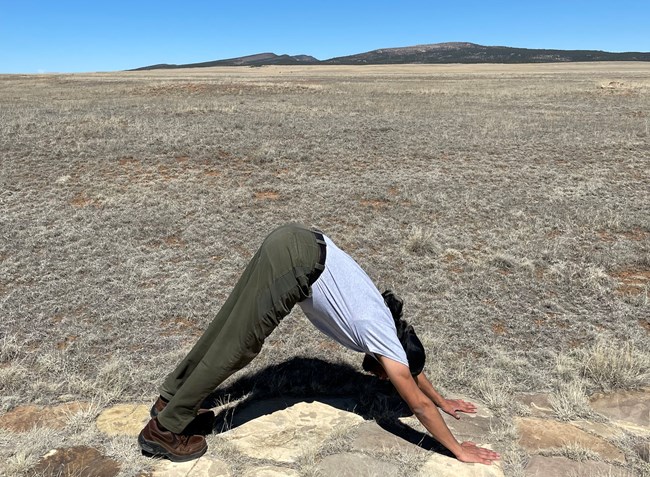
Turkey Mountains Pose
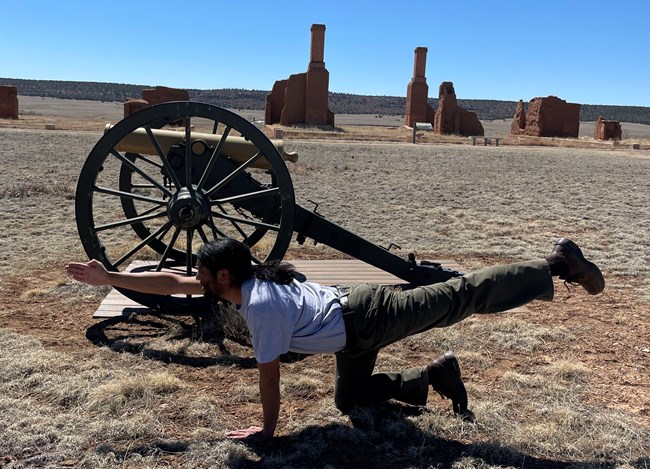
Cannon Pose
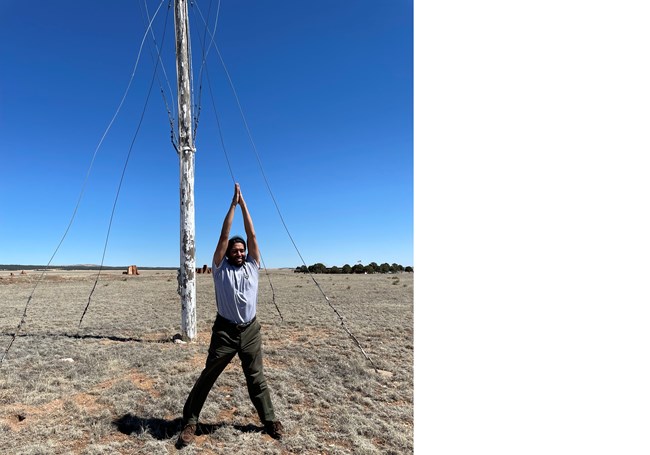
Flagpole Pose
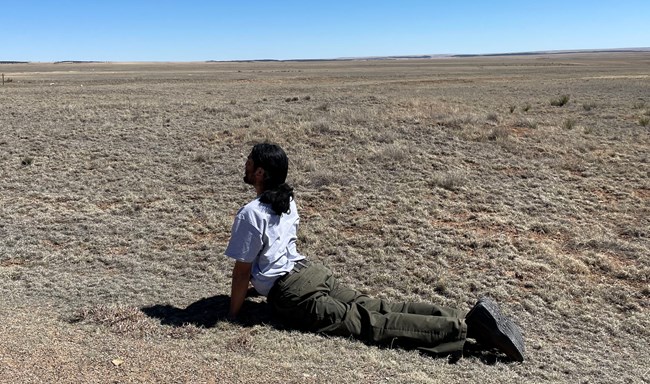
Prairie Rattler Pose
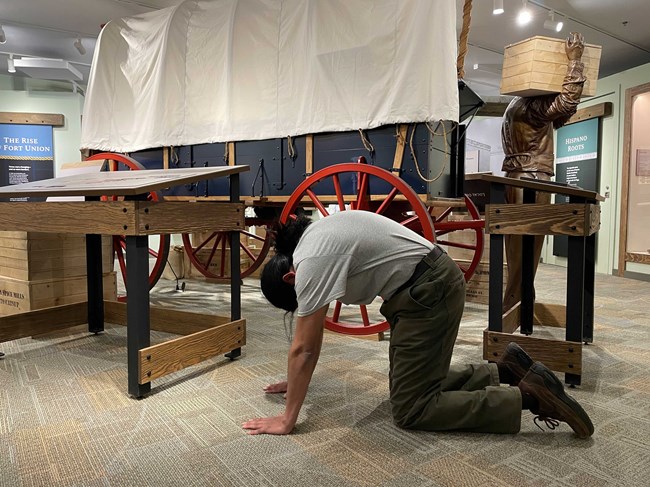
Covered Wagon Pose
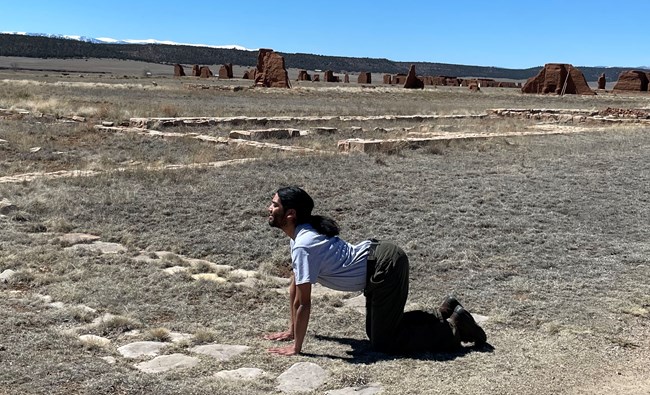
Pronghorn Pose
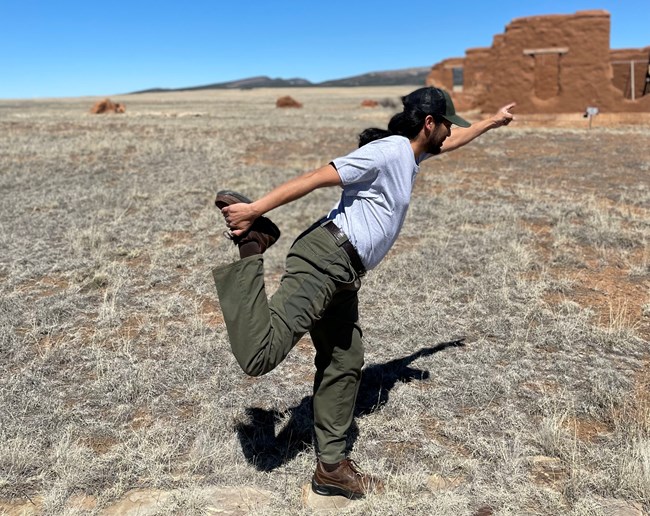
Park Ranger Pose
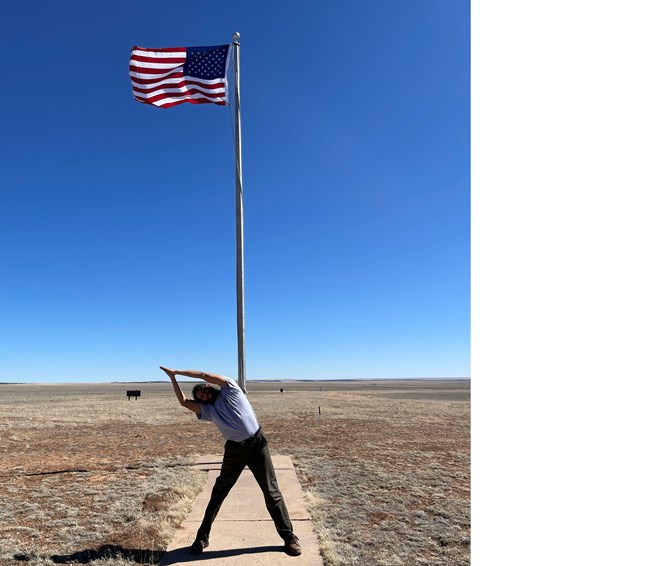
Windy Day Flag Pose
Last updated: May 15, 2024
Recommended
Jfk grounds flights on one of year’s busiest travel weekends due to thunderstorms.
Thanks for contacting us. We've received your submission.
One of the busiest airports in the US has been issued a ground stop amid a hectic Memorial Day travel weekend .
On Monday afternoon, John F. Kennedy International Airport in Queens, New York, was issued a ground stop by Air Traffic Control System Command Center, which is part of the Federal Aviation Administration (FAA).
Thunderstorms were listed as the cause for the ground stop.
The ground stop period is expected to last from 6:30 p.m. to 7:45 p.m. on Monday evening.
JFK Airport is considered one of the most bustling airports in the United States.
It is consistently rated among the top 10 busiest airport hubs in the US.
Fox News Digital reached out to the FAA for an additional statement.

This story is still developing. Check back with us for updates.
Share this article:
Watch CBS News
Best beach wagons for Memorial Day weekend and beyond
By Rachel Center
Edited By Fox Van Allen
May 22, 2024 / 6:06 PM EDT / Essentials
CBS Essentials is created independently of the CBS News editorial staff. We may receive commissions from some links to products on this page. Promotions are subject to availability and retailer terms.

Beach days are great fun, and we can't wait to spend as much time as we can down by the water this summer . But do you know what isn't so fun? Lugging all of your beach essentials to and from your car under the blistering hot sun. Not having the right transportation system in place can leave you feeling fatigued, starting your beach day on a bad note.
To avoid this altogether, get yourself a beach wagon. Beach wagons will do all the heavy lifting of your towels, chairs, cooler, umbrella and more for you, all you have to do is push or pull. There's still some work involved, yes, but carting your belongings through the sand is so much easier than carrying everything by hand.
Best beach wagons of 2024
To help you find the right beach wagon for your needs, we rounded up the best beach wagons for beach-going parties big and small. These wagons will get everything you need to the edge of the sand with ease, so all that's left to do is kick back, soak up the sun and enjoy the scenery.
Best overall beach wagon: Gorilla Carts 7-cubic-feet collapsible folding beach wagon
- Best small beach wagon: Vevor beach wonder bags & storage
Best push beach wagon: Beau Jardin collapsible folding beach wagon
Most stylish beach wagon: business & pleasure folding beach cart, most versatile beach wagon: mac sports 2-in-1 beach day folding chair .

The Gorilla Carts beach wagon offers ample room to store all your beach essentials, measuring three feet long and nearly two feet wide. In addition to plenty of space in the bed, the wagon also comes with many storage compartments both inside and out, including interior zip pockets that are great for personal items such as your wallet, phone or beach book, and a large exterior pocket that can hold beach towels, collapsible beach chairs and more.
The beach wagon also has cup holders on all four sides and all-terrain wheels with brakes. What's more, when you're all done using it, the beach wagon can break down about half its size for the easiest storage.
The Gorilla Carts 7-cubic-feet collapsible folding beach wagon has a 4.7-star rating on Amazon. One reviewer wrote , "So glad I purchased it! Good quality and durable. We have a huge Grizzly cooler that we usually take on weekend trips to the beach or a river along with our beach chairs, towels and snacks. This made it all so much easier."
Best small beach wagon: Vevor Beach Wonder

Those who usually beach it by themselves or with a couple of other loved ones will appreciate this small yet efficient beach wagon from Vevor. The beach wagon has several compartments big and small to store beach necessities, including a slot for your water bottle and a bottom storage base that's great for towels and collapsible chairs. You can store kids' toys in the mesh catch-all bag and put your tablet and some snacks in the storage bag next to the handles.
The rear balloon wheels will help you get across the sand with ease. Don't be afraid to load this little beach wagon up; the fabric is not only tear-proof, but the weight capacity is a whopping 350 pounds.
The Vevor Beach Wonder has a 4.5-star rating on Wayfair. One reviewer said that it "rolls well in the sand", while another customer wrote, "Very light and functional. Has space for everything for a beach day!"

Most large beach wagons have to be pulled from behind, which can end up causing trouble for your back. That's why we really like this Beau Jardin model, which has an adjustable push handle for a more comfortable transporting experience. It also comes with a pull-handle, giving you the chance to change your position while carting the beach wagon around.
The Beau Jardin collapsible folding beach wagon has a weight capacity of 350 pounds, is made of a fabric that is tear-resistant and waterproof and has 360-degree wheels with brakes and free-standing support to ensure it remains immobile while parked. Get this in one of four colors.
The Beau Jardin collapsible folding beach wagon has a 4.4-star rating on Amazon. One reviewer wrote , "If you have a bad back like me, pushing the wagon with the handlebars works way better than pulling it. I love this."
Another customer said , "The wagon is more spacious than I thought it would be. It fits all of our beach gear along with my toddler who still has plenty of room to wiggle around."

Most beach wagons are an eyesore. If you're willing to spend extra money to have your belongings travel in style on the way down to the sand, splurge on this Business & Pleasure folding beach cart. The beach wagon is quite pretty with its blue- and white-striped exterior pattern, rich navy interior, faux leather details, white frame and wood handle.
It's functional as well, with four wheels made of plastic and rubber that have traction to ease pulling it through the sand. The beach cart has a strip of mesh lining that'll make it a breeze to brush the sand away that has collected at the bottom of the cart. Plus, you can fold it up at the end of the day, so it won't take up as much space in your trunk or garage.

Why transport your chair to the beach when you can get one built into your beach wagon? Say hello to a whole new way of beaching it with the Mac Sports 2-in-1 beach day folding chair. Pulling this across the beach will be easy with the pull-handle built into the back of the chair, as well as the two exterior wheels, both of which have nice traction on them. The chair also comes with armrests and a footrest, allowing you to fully stretch out and relax your body.
As for storage, the removable mesh bag that is held between the backrest and footrest can hold beach supplies, including a small cooler, towels, some beach toys and even an umbrella.
The Mac Sports 2-in-1 beach day folding chair has a 4.5-star rating on Wayfair. One reviewer wrote , "Love it. It has made going to the beach solo so much easier. My small dog goes with me and often rides on top of 'stuff' from car to beach. So glad I made the purchase."
Rachel Center is a writer with more than eight years of experience creating lifestyle content for brands such as Better Homes & Gardens, Real Simple and Apartment Therapy.
More Essentials

Best deals on robot vacuums ahead of summer
It's time for a thorough house cleaning this spring, and a robot vacuum can help you do all the heavy lifting.

Best Buy has huge deals on TVs during its summer kick-off sale
Save hundreds on TVs from top brands like Samsung, LG, TCL and more at Best Buy's summer sale.

Your hearing aid specialist should know these five things
Make sure your hearing aid specialist knows these five key things for a professional and reliable experience.

The best pre-built gaming computers in 2024
Explore the best gaming computers of 2024 including top-rated gaming PCs and gaming laptops.

How much does solar cost?
Everything you need to know about the cost of solar panels, as well as incentives like that federal tax credit

Best car seats for keeping baby safe and comfortable
Keep your bundle of joy safe and comfortable with the best infant and convertible car seats for babies this year.

Most useful travel products on Amazon under $50
Traveling on a budget this summer? You'll feel luxurious using these affordable travel items that cost $50 or less.

How to watch Dallas Stars vs. Edmonton Oilers, Game 4
Don't miss the NHL Western Conference finals as the Dallas Stars face the Edmonton Oilers tonight in Game 4.

The best RFID-blocking wallets and bags for 2024
An RFID-blocking wallet can prevent someone from wirelessly stealing credit card numbers and other personal data.

Trump trial ends first day of jury deliberations without a verdict
The first day of jury deliberations in former President Donald Trump's "hush money" trial ended without a verdict as jurors asked to review several portions of testimony.

Some companies plan to increase return-to-office requirements in 2025
Although 8 out of 10 companies say they have lost talent because of their RTO policy, the majority of business leaders support the mandates.

6th house collapses into ocean along North Carolina's Outer Banks
U.S. National Park Service officials say an unoccupied house has collapsed into the Atlantic Ocean along North Carolina's Outer Banks.

American Airlines hits rough air after strategic missteps
American Airlines shares plummet after CEO acknowledges stumble ahead of the lucrative summer travel season.

Feds take down one of world's largest malicious botnets
The 911 S5 Botnet deployed 19 million compromised IP addresses in over 190 countries, using them to carry out bomb threats, fraud, child exploitation and more, the Justice Department said.

As investors pour in, for-profit nursing homes leave some seniors in need
A CBS News investigation found concerns over care emerged after a for-profit chain took over some California nursing homes.

Golden Goose sneakers look used. The company could be worth $3 billion.
The deliberately distressed sneakers, made to look pre-worn, have found a market among A-list celebs and younger consumers.

Top McDonald's exec says $18 Big Mac meal is "exception," not the rule
The fast-food giant is doing its best to keep prices reasonable for consumers, says McDonald's USA President Joe Erlinger.

Texas runoff election sets races for November after Republican party civil war
While Texas House Speaker Dade Phelan survived the runoff, six of the eight Republican incumbents on Tuesday night lost to challengers.

House Ethics Committee investigating indicted Rep. Henry Cuellar
Rep. Henry Cuellar and his wife are accused of accepting nearly $600,000 in bribes from an Azerbaijani energy company and a bank in Mexico.

RFK Jr. files FEC complaint over June 27 presidential debate criteria
RFK Jr. is accusing CNN of differing standards for him versus former President Donald Trump and President Biden in the June 27 presidential debate criteria.
HealthWatch

These are 3 of the worst foods for teeth
Are you aware of the impact food has on your dental health? Dental experts share some tips on food to be aware of and how to protect your teeth from damage.

Millions of Iowa chickens to be killed amid bird flu outbreak
The steep loss from the top egg-producing state triggered a disaster proclamation from Iowa's governor.

The bird flu vaccine is made with eggs. That has scientists worried.
The spread of an avian flu virus in cattle has again brought public health attention to the potential for a global pandemic. Fighting it would depend, for now, on 1940s technology that makes vaccines from hens' eggs.

Why American sunscreen options are limited compared to other countries
How do American sunscreens stack up against others around the world? A 1938 law may be blocking your best options for skin cancer protection.

3 of the worst foods for your teeth, according to dental experts
Candy is not great for your teeth, but experts say there are three other types of foods and drinks to be mindful about for better oral health.

Delhi temperature may break record for India's highest: 126.1 degrees
A substation in Delhi gave a preliminary reading of 126.1 degrees Fahrenheit this week amid a heat wave.

Ancient remains of 28 horses were found buried in France. How did they die?
The horses were found "carefully" arranged and had all been "buried simultaneously," researchers said, but there were scarce clues left as to how and why the animals died.

Person dies after falling into engine of departing passenger jet
"A person ended up in a running aircraft engine," Dutch flagship carrier KLM said in a statement.

U.S.-made bomb used in deadly Israeli strike on Rafah, experts say
Analysis of images of shrapnel gathered at the scene of an Israeli strike in Rafah on Sunday showed evidence of a bomb that was a U.S.-made GBU-39
- updated 43M ago

Another mayoral candidate murdered days before Mexico elections
Thirty candidates have been killed in Mexico this campaign season, according to the nongovernmental organization Data Civica.
Entertainment

Millie Bobby Brown marries Jake Bongiovi
"The bride looked gorgeous and Jake is as happy as can be," Jon Bon Jovi said.

Albert Ruddy, Oscar-winning producer of "The Godfather," dies at 94
Albert S. Ruddy, who won Oscars for "The Godfather" and "Million-Dollar Baby" and helped create TV's "Hogan's Heroes," died Saturday.

Richard Dreyfuss' remarks about women, diversity lead venue to apologize
A venue issued an apology after actor Richard Dreyfuss made allegedly sexist and homophobic comments at a "Jaws" event on Saturday.

Annapolis Pride Parade taking new route with 'Project Runway' winner Christian Siriano at head
Fashion designer and Maryland native Christian Siriano will be the Grand Marshall for the 2024 Annapolis Pride Parade, which will have a new route this year.

John Grisham talks history of "Camino Ghosts"
Bestselling author John Grisham is returning to the beach with his latest page-turner. His book "Camino Ghosts" is the third in his Camino Island trilogy. He talks to "CBS Mornings" about the important history behind the book.

World's first wooden satellite built by Japanese researchers
The world's first wooden satellite has been built by Japanese researchers who said their tiny cuboid craft is scheduled to be carried into space on a SpaceX rocket in September.

How AI tackles school bus driver shortages
Some school districts are turning to technology like artificial intelligence to help tackle major bus driver shortages. A school district in Colorado shows how their system could become a model nationwide.

How AI powered robots are helping small farms
From labor shortages to environmental impacts, farmers are looking to AI to help revolutionize the agriculture industry. One California startup, Farm-ng, is tapping into the power of AI and robotics to perform a wide range of tasks, including seeding, weeding and harvesting.

How one school district is turning to AI to solve its bus driver shortage
A severe school bus driver shortage has left many students without reliable transportation but a district in Colorado Springs has found a high-tech solution.

How new technology is transforming airport security, efficiency
Advocates say the technology, including facial recognition, will lead to improved security and efficiency, but some remain concerned about privacy.

Tom Steyer on how to beat climate change
Can the climate crisis be won as temperatures soar, oceans rise and air quality deteriorates? Former presidential candidate Tom Steyer thinks it can. The climate investor joins "America Decides" to discuss his new book "Cheaper, Faster, Better: How We'll Win the Climate War."

How climate change impacts flight turbulence
Turbulence on flights has been increasing, and climate change could be one of the reasons why. CBS News senior weather producer David Parkinson explains how the human-caused phenomenon affects the flight path.

Protecting nature across America
One million species worldwide are threatened with extinction, according to the United Nations. One of the reasons is climate change. As dire as it sounds, there are many communities working to protect the Earth and those threatened species.

Euclid telescope captures dazzling new images of cosmos
Shining galaxies, a purple and orange star nursery and a spiral galaxy are among the new images.

Solar storm forecasts could improve after new discovery about sun
New research indicates the sun's magnetic field originates much closer to the surface than previously thought, a finding that could help predict extreme solar storms.

Scott Peterson in court amid bid to test DNA
Convicted killer Scott Peterson was back in court Wednesday as his new lawyers with the Los Angeles Innocence Project requested DNA evidence from the original investigation. CBS News correspondent Elise Preston has the latest.

U.S. returns $80M worth of stolen Italian art
The U.S. has returned millions of dollars worth of stolen artifacts to Italy. The collection includes hundreds of trafficked valuables, from tiny Roman coins to life-size bronze statues. CBS News' Ian Lee reports.

Jury starts deliberations in case of Chad Daybell, accused of 3 murders
Chad Daybell married Lori Vallow two weeks after the death of his wife, Tammy Daybell. The bodies of Vallow's children were found on his property months after they were reported missing.

Judge in Scott Peterson case allows new DNA test on one piece of evidence
A judge presiding over convicted killer Scott Peterson's latest bid for a new trial on Wednesday afternoon ruled that only one piece of evidence will be allowed a new round of DNA testing.
- updated 44M ago

Radar detects fresh lava flows on Venus, indicating active volcanoes
Scientists used decades-old images to track changes on the planet's surface.

NASA says helium leak poses no safety threat to Boeing's Starliner capsule
Engineers are confident the leak will not worsen in flight, and even if it does, the Starliner can safely launch June 1.

A rare 6-planet alignment will occur soon. Here's what to know.
The orbits of six planets will bring them to the same side of the sun to create a "planetary parade" in early June.

Boeing's Starliner facing additional delay for extended leak analysis
NASA managers have ordered additional reviews of a small helium leak in Boeing's Starliner spacecraft to make sure it can be safely launched as is.
Latest Galleries

Notable Deaths in 2024
A look back at the esteemed personalities who've left us this year, who'd touched us with their innovation, creativity and humanity.

Becky Bliefnick texted about fear of her estranged husband
The Illinois mom wrote, "If something ever happens to me, please make sure the number one person of interest is Tim." Take a look at the evidence that led to Tim Bliefnick's arrest.

The hunt for Forrest Fenn's treasure
Forrest Fenn hid a treasure somewhere in the Rocky Mountains. Five men died searching for it.

The Circleville letters: You've got hate mail
An anonymous letter writer terrorizes a small town, threatening to expose their rumored dark secrets.

Roger Corman, "King of the B Movies" 1926-2024
A look back at the hallowed career of the indie "B-movie" filmmaker, known for exploitation films, monster flicks, and some bizarre movie posters.
Latest CBS News Videos

Breaking down the NCAA settlement
College athletics will soon change forever thanks to a new pay structure for schools and athletes. That's because the NCAA and the nation's five biggest conferences have agreed to pay nearly $3 billion to settle multiple antitrust claims. CBS News reporter Taurean Small has the details.

Examining the presidential transition process
The executive branch is preparing for what happens after the 2024 election, and the possibility they'll have to pack up and make way for a new administration. The Partnership for Public Service, a Washington, D.C.-based nonprofit, breaks the transition into three phases -- with one already underway. President and CEO Max Stier joins CBS News to take a deeper look at the lengthy process.

U.S.-made bombs used in Rafah strike, experts say
Several independent weapons experts told CBS News that images gathered from the blast site of Sunday's Israeli airstrike on the southern Gaza city of Rafah, which killed dozens of Palestinians, shows clear evidence that an American-made GBU-39 warhead was used in the attack. Imtiaz Tyab reports from East Jerusalem.

IMAGES
VIDEO
COMMENTS
Eighteen to twenty miles a day over prairie was considered a good days travel. Pioneers were awakened shortly before daybreak by the sound of a bugle or a shotgun from the guard. After several days on the trail, certain routines were followed: 4:00 am: A bugler blows a trumpet or a rifle is fired by the night guards to wake up the camp.
If it rained, they might only be able to travel one or two miles a day, due to washed-out trails. Most covered wagon families could travel about 10-15 miles a day; carrying all that weight, it must have been agonizingly slow at times. Amelia Stewart Knight wrote in her diary on September 8, 1853, at the end of a long and treacherous day:
They would travel in packs — wagon trains, a collective of like-minded folk, guided by someone who claimed to know where they were going and the best way to get there (though that didn't always work out — ask the Donner Party).Migration began in earnest with the opening of the Santa Fe Trail in the 1820s, then picked up considerably with wagons headed for Oregon and California in the 1840s ...
Typically, the nooning time is just an hour. In the heat of summer, though, some parties opt to "lay by" for a few hours, preferring instead to travel at night and in the cooler hours of the day. Related read: 7 Tantalizing Stories of Lost Treasure in Oregon. 1 p.m. - Back on the Trail. The emigrants resume their journey.
prairie schooner, 19th-century covered wagon popularly used by emigrants traveling to the American West. In particular, it was the vehicle of choice on the Oregon Trail.The name prairie schooner was derived from the wagon's white canvas cover, or bonnet, which gave it the appearance, from a distance, of the sailing ship known as a schooner.. The prairie schooner was smaller and lighter than ...
That year, Marcus helped lead the first major wagon train of around 1,000 settlers along the Oregon Trail, an exodus now known as the "Great Migration.". Traffic soon skyrocketed, and by the ...
The Conestoga wagon was a heavy American wagon of English and German type from the late 18th century and into the 19th century. It was used for freight and drawn by teams of horses or oxen depending on load. The covered canvas top was supported on eight to twelve angled bows, rather than upright. Capacity was around 4 to 5 tons with no springs.
A slow-moving, covered wagon, travelling at about four miles an hour, turned out to be an almost ideal vehicle for a social observatory to understand and see the America of today.
This ca. 1840-1850 Conestoga wagon, a freight hauler in Pennsylvania, represents the role of covered wagons in pushing the American frontier westward. ... Rugged but scientifically designed, the Conestoga wagon was the 18-wheeler of its day, the undisputed king of the road in a procession of freight wagons that formed an umbilicus from ...
day began on the trail west. After five or six hours of travel, the wagon master looked for a noonday resting place. Wagons pulled to a stop and the oxen were unhitched to rest and graze. Families and friends gathered to eat a cold lunch, often leftovers from yesterday's supper. It was a brief time for the weary travelers
When Rinker Buck decided to hit the Oregon Trail in a covered wagon, he didn't realize what he'd signed up for. The author of The Oregon Trail holds forth on near death experiences, pioneer tales, and the truth about America's westward trail. By Fiona McCann July 29, 2015. Rinker Buck on the Oregon Trail. (Photo courtesy Rinker Buck)
The covered wagon made 8 to 20 miles per day depending upon weather, roadway conditions and the health of the travelers. It could take up to six months or longer to reach their destination. Nowadays, we travel hundreds of miles in a day concerned only with reaching the campground before dark so that electric and water can be hooked up during ...
Covered wagons moved very, very slowly. The average covered wagon in the Old West made it anywhere from 8-20 miles (13-32 kilometers) per day. On flat terrain and in good conditions, those 20-mile days could really help push the pace. But across more mountainous terrain, in dangerous zones, or while dealing with difficult weather, the speed of ...
Perhaps the largest wagon train to travel on the Oregon Trail left Missouri in 1843 with over 100 wagons, 1,000 men, women and children, and 5,000 head of oxen and cattle. The train was led by a Methodist missionary named Dr. Elijah White. But wagon trains became so common on the trail that processions seemed to have no beginning or end.
Travel Across 25 U.S. States and Stay in a Modern-day Oregon Trail-style Covered Wagon. Conestoga wagons are available at resorts in 25 U.S. states. By. Jessica Poitevien. Published on March 26 ...
Although terrain made a difference, on a typical day, Conestoga wagons would travel between 12 and 14 miles. ... the covered wagon was a smaller version of a Conestoga wagon, designed to move ...
Five Day Historic Wagon Train and horse ride to So pass. Yellowstone 1883 Wagon Train is like our Five day Covered Wagon Trek. You are riding on Historic Wooden Wheel Wagons that have been on the Oregon and California Trails. A trail of excitement, hope and challenge. A trail of real life and death. A trail of great achievement and disappointment.
Those attending will investigate the features of the covered wagon, and learn how to pack for a long journey, and how pioneers cooked, slept, dressed and played during their travels. The camp is for ages 6 to 12 and limited to 12 campers per day. COVID-19 precautions will be taken. The cost per camp day is $35. Campers will meet at the Rodkey ...
On average, a horse-drawn carriage can travel between 10-30 miles a day. The distance will depend on factors such as terrain, weather, horse, and weight of the carriage. In hot weather, a horse's workload should be reduced in order to prevent overheating. When the humidity and temperature add up to 150-160, a horse should only do light work.
The first covered wagon reached California after an exhausting and life-threatening trip of over 6 months! In May of 1841, about 70 people set out from Independence, Missouri, in Conestoga-style wagons, heading towards the west coast. They were determined to be the first pioneers to cross the Rocky Mountains to reach the west coast.
Welcome to Scenic Excursions - Greater Rochester! We are excited to announce that as of August 30, 2021, our formerly known tour divisions of Niagara Scenic, Know How Tours, Covered Wagon Tours & Bradford Travel have rebranded to become Scenic Excursions - Greater Rochester.
Wagon trains were the safest way to travel, but there were still many dangers that the traveling families faced. Typically, in a wagon train, families would walk alongside their wagon all day ...
Take a hike during your visit to Scotts Bluff. Hiking gives families a chance to explore the summit or take a one-way hike back to the Visitor Center. North Overlook Trail is a paved .5-mile (.8 ...
Covered Wagon Pose While on all fours arch your back upwards to create a lower-case n-shape while looking at your stomach. This pose is great to do with the Pronghorn Pose. Just do them back and forth, holding each pose and exhaling for a moment, before switching. Fort Union was a major stop on the Santa Fe Trail, which carried hundreds of ...
One of the busiest airports in the US has been issued a ground stop amid a hectic Memorial Day travel weekend. On Monday afternoon, John F. Kennedy International Airport in Queens, New York, was ...
Best overall beach wagon: Gorilla Carts 7-cubic-feet collapsible folding beach wagon. Best small beach wagon: Vevor beach wonder bags & storage. Best push beach wagon: Beau Jardin collapsible ...